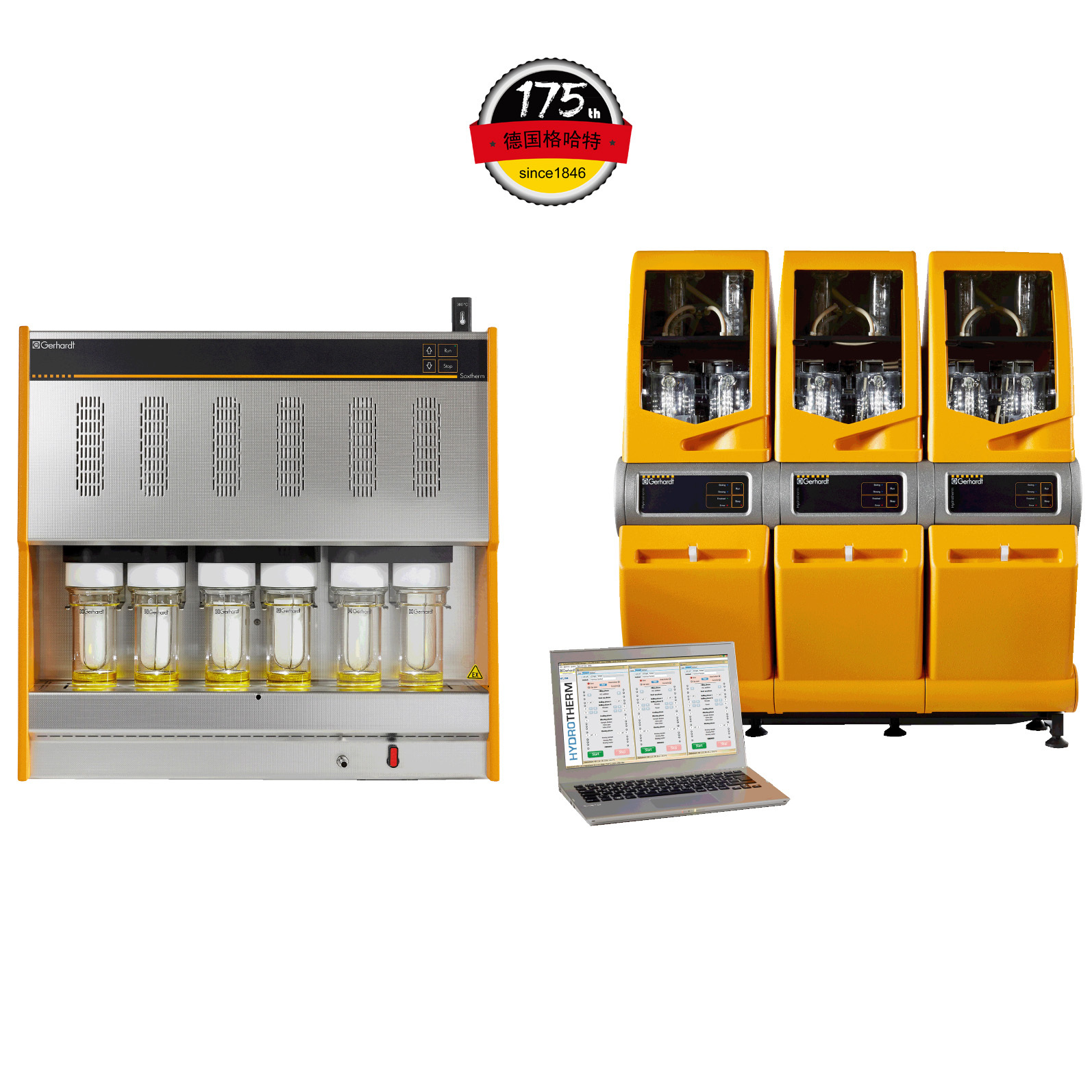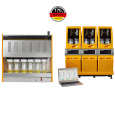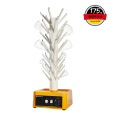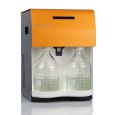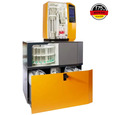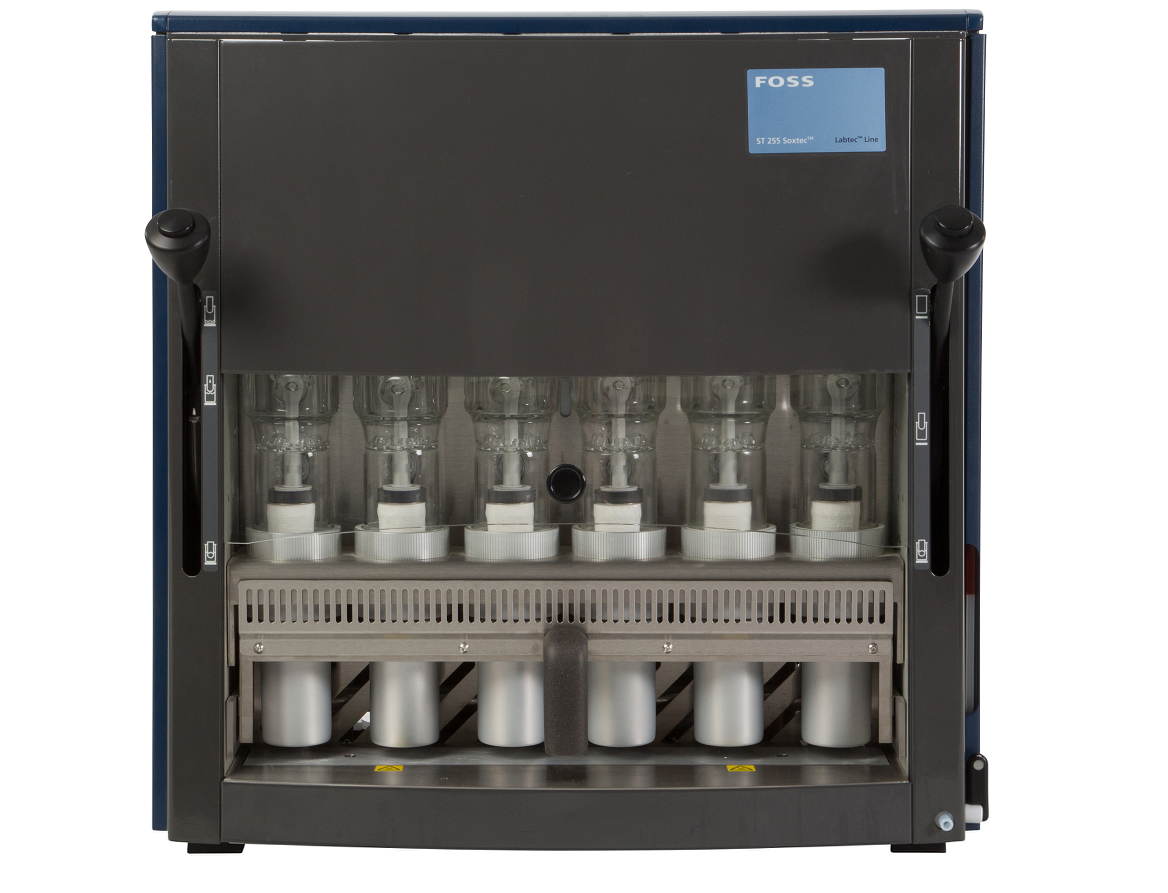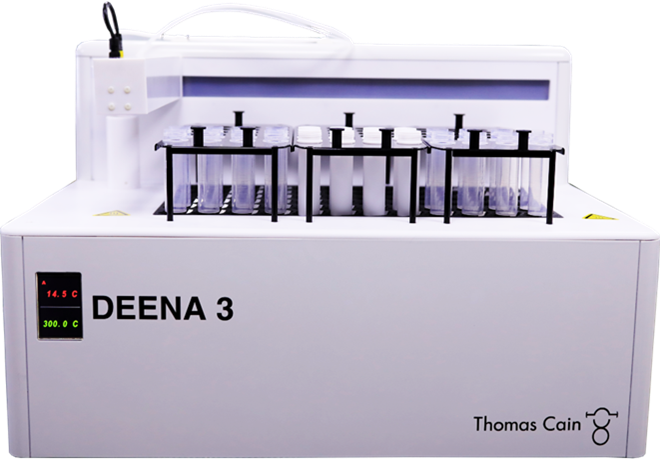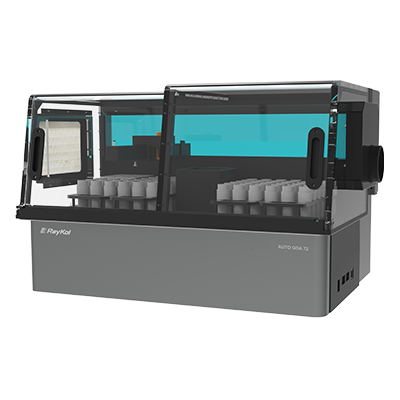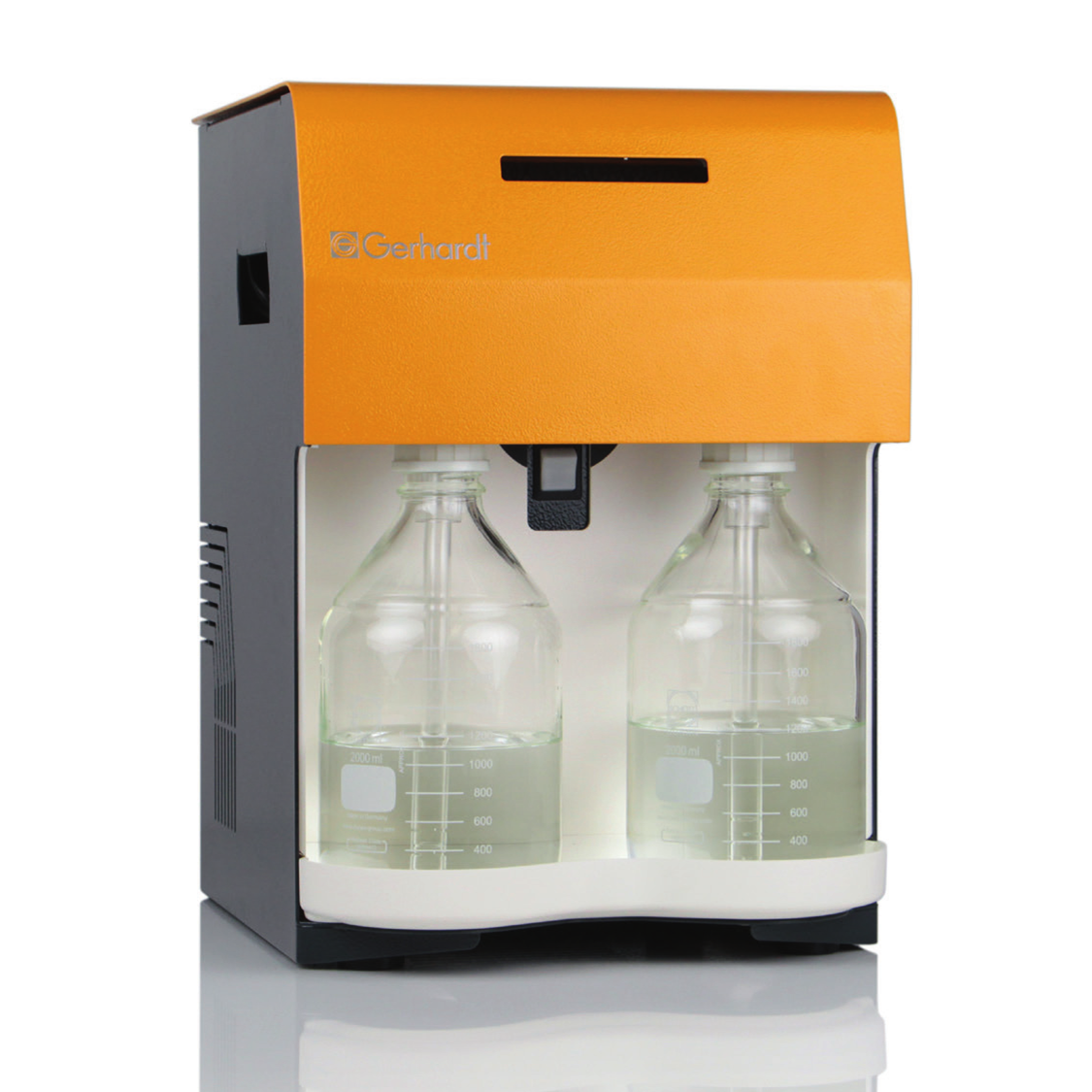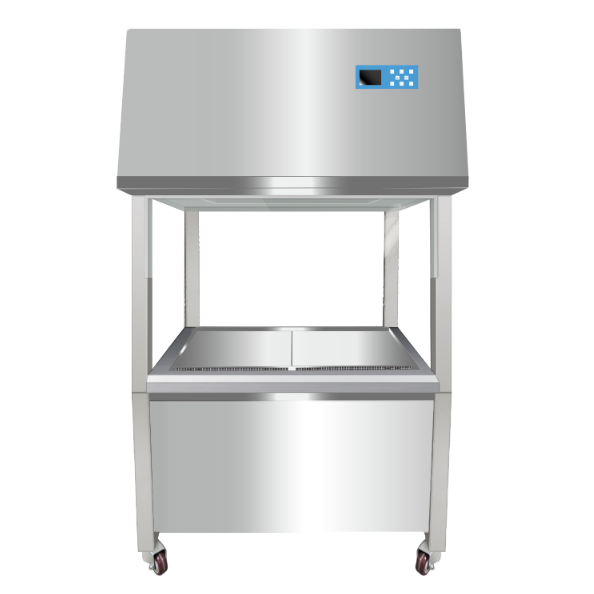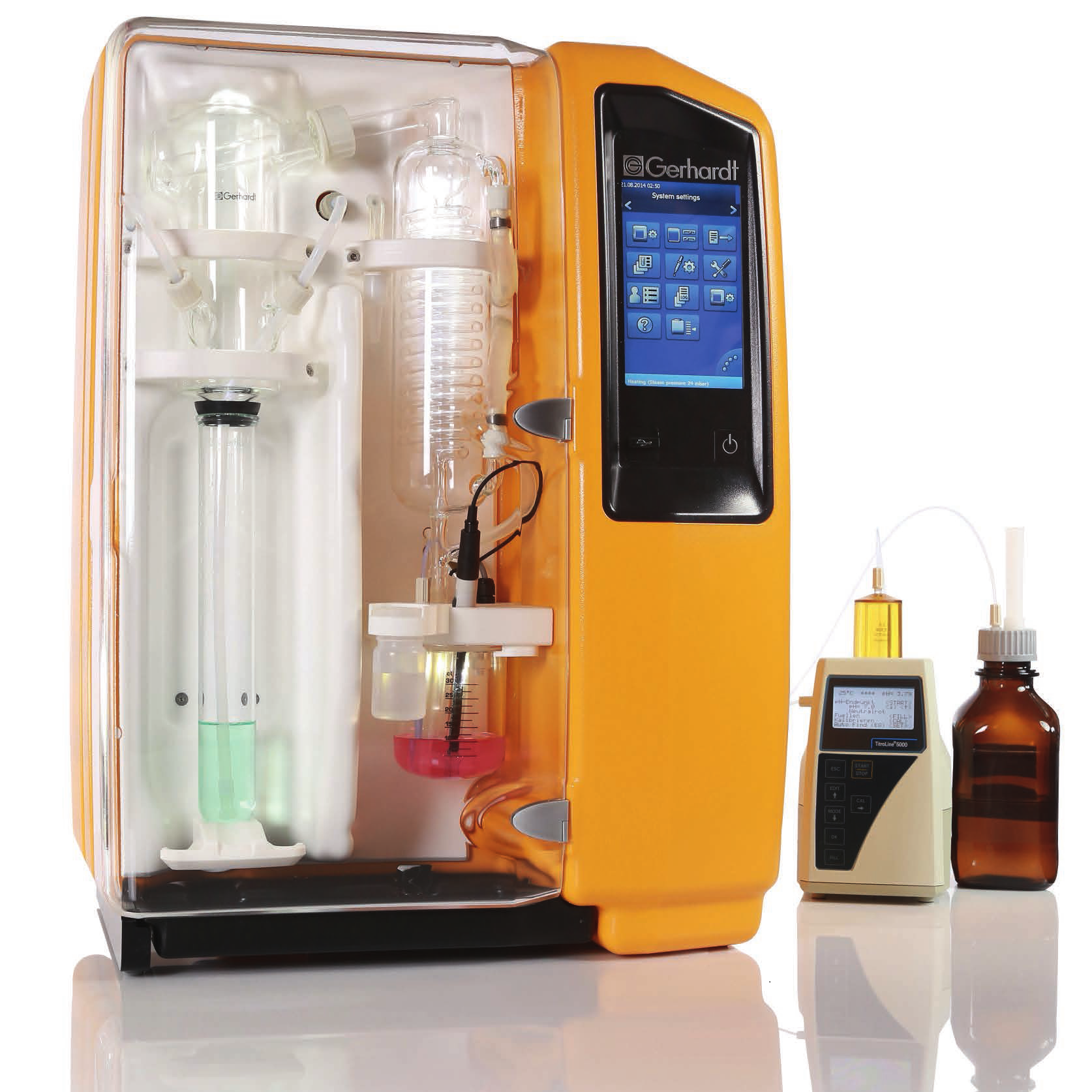方案详情
文
本地土猪和杂交猪供应链条猪肉的胴体组成和理化特性Carcass Composition and Physicochemical Characteristics of Meat from Pork Chains Based on Native and Hybrid Pigs
方案详情

本地土猪和杂交猪供应链条猪肉的胴体组成和理化特性Carcass Composition and Physicochemical Characteristics of Meat from Pork Chains Based on Native and Hybrid Pigs2 of 13Processes 2022,10,370 :processe 本地土猪和杂交猪供应链条猪肉的洞体组成和理化特性 Article Carcass Composition and Physicochemical Characteristics of Meat from Pork Chains Based on Native and Hybrid Pigs Goran Kusec 1D , Miodrag Komlenic 2, Kristina Gvozdanovic11D , Velimir Sili 2, Marina Krvavica 3D Zarko Radisic1 and Ivona Djurkin Kusec 1,*D Faculty of Agrobiotechnical Sciences Osijek, Josip Juraj Strossmayer University of Osijek, Vladimira Preloga 1,31000 Osijek, Croatia; gkusec@fazos.hr (G.K.); kgvozdanovic@fazos.hr (K.G.); zradisic@fazos.hr (Z.R.) 2 Belje Plus, Ulica Svetog Ivana Krstitelja 1A, 31326 Darda, Croatia; miodrag.komlenic@bel j e.hr (M.K.);velimir.sili@belje.hr (V.S.) 3 Polytechnic Marko Marulic in Knin, Petra KreSimira IV 30, 22300 Knin, Croatia; mkrvavica@veleknin.hr Correspondence: i durkin@fazos.hr; Tel .: +385-31554868 Abstract: The purpose of the research was to investigate the carcass composition, meat quality and chemical composition of pigs from two pork chains for t he production of t raditional dry/cured products in Croatia. The trial involved 24 Black Slavonian barrows reared outdoors (NAT chain)and 24 PIC hybrid barrows kept under industrial conditions (INT chain); all animal s were raised to 160 kg of live weight. After slaughter, carcass and meat quality traits were measured and samples for chemical composition were taken. After that, a full dissection of the carcasses was performed.The pigs from t he INT pork chain had leaner carcasses, higher bone percentages, and lower fatness levels than the NAT carcasses. Pigs from the NAT chain exhibited a more desirable meat quality.No di f ferences were found in moisture, and samples from the INT chain exhibited higher collagen and protein percentage. Muscles from the NAT chain had higher IMF and MUFA levels, and the SFA content was lower than i n INT pork. Despite the superior carcass traits of the pigs from the INT chain,pigs from t he NAT chain demonstrated better suitability for the production of dry/cured products. Citation: Kusec, G.; Komlenic,M.;Gvozdanovic,K.; Si li, V.; Krvavica,M.; Radisic,z ; Kusec , I.D. Carcass Composition and Physicochemical Characteristics of Meat from Pork Chains Based on Na t ive and Hybrid Pigs. Processes 2022,10,370. https://doi .org/10.3390/pr10020370 Keywords: production system; carcass composition; meat quality; f at quality 1. Introduction Academic Editor: Dariusz Dziki Received: 14 December 2021 Accepted: 11 February 2022 Published: 14 February 2022 Publisher's Note: MDPI stays neutral with regard to jurisdict i onal claims in published maps and institutiona l af fi l -iations. Most of the pork today comes from modern breeds or hybrids exhibiting cer t ain advantages over native breeds, such as a high prolificacy, very fast growth and increased lean meat percentages in the carcasses. On the other hand, those animals are extremely sensitive to microclimatic condition changes and are often prone to stress and diseases.For t hese reasons, the production of such pigs requires very stric t management and housing conditions. Additionally, their meat is often characterized by unsatisfactory quality traits such as high drip loss, colour deterioration and reduced intramuscular fat content (IMF),thus making i t less suitable for processing into products [1], especially high-quality those of high quality or labelled with protected denomination of origin (PDO) or protected geographic indication (PGI ). Copyright: @ 2022 by the authors.L i censee MDPI, Basel, Switzerland.This article is an open access article distr i buted under the terms and conditions of the Creative Commons Attribution (CC BY ) l icense (https://creativecommons.org/licenses/by/4.0/) It is a growing trend that consumers today demand tasty, locally produced food originating from environment- and animal-friendly production systems [2]. Over 80 pork production systems in European countries have been recognized, with approximately half of them considered conventional and half considered alternative based on claims on improved eating quality, animal welfare, environmental impact, local impact, etc.[3].Claims of higher meat quality rely on the assumption that it can be improved by choosing the appropriate breed , rearing system, and/or feeding strategy combined into a specific quality pork chain. Some pork chains are based on local breeds kept in extensive rearing conditions,and in some chains, conventiona l hybrids are reared in an i ntensive production system with limited specifications such as higher slaughter weight and specified minimum age at slaughter. Such management practices in this kind of pig production can lead to the improvement of meat quality [4,5], resulting in mea t that is more suitable for processing into high-quality products. The fatty acid (FA) profile, whether in adipose or muscle tissue, plays a signif i cant role in the formation of taste but also contributes to various aspects of meat quality and the nutritional status of meat. Muscle contains significant proportions of long-chain (C20-22)PUFAs. Due to the higher incorporation of 18:2n-6 acids, pig muscle produces higher levels of 20:4n-6, resulting in higher n-6/n-3 PUFA content compared to the muscle of the ruminants [14]. Many factors influence t he fatty acid profile in pigs, including breed/genetic type [14],the propor t ion of fat in the carcass [15], and the pig’s diet. Gan et al. (2020) [6] found that the FA profile of animals raised outdoors was richer in MUFA compared to the meat of intensively raised animals due to natural feed sources rich in unsaturated fatty acids.The Black Slavonian (Crna slavonska) pig is one of the Croatian native breeds created in the early 19th century by planned crossings between the Mangalitsa, Berkshire, Poland China, and Large Black pig [16]. This is a combined meat-fatty type of pig characterized by excellent meat quality t raits and rather high IMF content [17], because of which i ts meat is considered a delicacy when prepared as a dish, though it is much more often processed into highly valued t raditional dry/cured products. The best performance of t his breed is achieved when raised in extensive or semi-intensive conditions, which can lead to a higher slaughter weight of approximately 135-160 kg [18]. Therefore, the aim of the present study was to investigate and compare carcass com-position and meat quality traits of pigs from two different pork chains for the production of traditiona l dry/cured products. One is based on a native breed, Black Slavonian (BS)pig, reared in the outdoor farming system with ad libitum access to feed; the other chain involves modern, hybrid pigs reared in the intensive system typical for i ndustrial pig production, only with a prolonged fattening period. 2. Materials and Methods 2.1. Animals, Production Chains, and Slaughter Procedure The experimental protocol was approved by the Bioethics Committee of the Faculty of Agrobiotechnical Sciences Osijek (602-04/21-01/07), and all procedures were performed in accordance with the Croatian Animal Welfare Act and other legal acts regulating animal husbandry and welfare. Animals used in the present study originated from two production chains: one based on a Croatian native pig breed (NAT) and the other based on hybrid pigs reared in a prolonged fattening period (INT). The NAT pork chain sample consisted of Black Slavonian pig barrows (n =24) and t he INT chain Pietrain involved PIC (Pig Improvement Company;P337 (Pietrain × Duroc × Pietrain) x Camborough 23) (n=24) hybrids. The animals from both pork chains were littermates originating from six litters farrowed within two weeks.The animals were randomly assigned to each of the treatments, and the treatments were performed in duplicate. The NAT pork chain is a local specific system for Black Slavonian pigs kept in pas-tures that allow 300 m² space per pig with 80 m² of the canopy to protect animals from uncomfortable climate conditions. Feeding was based on alfalfa ad libitum, with the daily addition of 2 kg whole grains. The INT pork chain sample consisted of PIC hybrid pigs that were reared in an intensive indoor production system with ad libitum access to food and water in a prolonged fattening period. The fatteners were group-penned. During the experiment, pigs were fed five different commercial diets consisting of 13.58 MJ/ME and 17.36 g/kg of crude protein (CP) to 30 kg of live weight (LW), 13.50 MJ/ME and 16.00 g/kg of CP f rom 30 to 55 kg LW,13.05 MJ/ME and 14.00 g/kg of CP from 55 to 85 kg LW, 13.00 MJ/ME and 13.99 g/kg of CP from 85 to 115 kg LW, and 12.81 MJ/ME and 13.01 g/kg of CP from 115 to 160 kg slaughter weight. The composition of the supplemented feed for BS fatteners and diet fed from 115 kg to approximately 160 kg LW for PIC porkers is presented in Table 1. Table 1. Nutritional value of pig diets used in the study. Composition Finisher-BS Finisher-PIC Dry matter,% 一 88.340 Crude protein, % 13.230 13.008 ME,MJ/kg 12.91 12.81 Crude fibre,% 5.840 5.999 Crude fat, % 2.840 3.224 Ash,% 4.360 4.406 Methionine,% 一 0.265 Methionine + cysteine,% 0.410 0.476 Lysine,% 0.710 0.696 Threonine,% 一 0.452 Thryptofane,% 0.1498 Ca,% 0.740 0.7458 Phosphate,% 0.365 Moisture,% 一 11.312 Vitamin K, mg/kg 一 4877.530 Vitamin A, IJ/kg 5200.000 6400.401 Vitamin D3,IJ/kg 960.000 960.000 Vitamin E,mg/kg 一 40.000 Phytase 400.000 400.000 Neutral detergent fibre,% 一 14.677 Acid detergent fibre,% 一 9.500 BS-Black Slavonian pig; PIC -Pig Improvement Company. After reaching the designated LW of 160 ±3 kg (at the approximate age of 2 years for pigs from the NAT chain and 7 months for pigs from the INT chain), the animals were transported to a near abattoir where they were exsanguinated following stunning with CO2. To enhance pig welfare, food safety and meat quality, animals were fasted for 18 h before slaughter. 2.2. Carcass Traits After 24 h of cooling, carcass length (distance from the cranial edge of Os pubis to the cranial edge of the 1st rib) and ham length (from the anterior edge of the Symphysis ossis pubis to the hock joint), together with the ham circumference at i ts widest point, were measured. The ham index was determined as the ratio between ham length and ham circumference. Muscle t hickness and fat thickness were determined using the "Two points (TP)" method approved in Croatia [19]. At the slaughterhouse after 24 h of cooling, the left sides of the pig carcasses were dissected according to the modified"Kulmbach" method [20], as schematically presented in Figure 1. The main parts were then further dissected into muscle t issue, fatty tissue (i ntermuscular and subcutaneous with skin) and bone, and then they were weighed. The weights of the parts (dissected and non-dissected) were measured using a Mettler-Toledo Viper SW 15 scale (Mettler-Toledo, Greifensee, Switzerland). Figure 1. Dissection scheme for the modified"Kulmbach" method (1. ham; 2. loin; 3. belly/rib;4. neck;5. shoulder). 2.2.1. Meat Quality Traits Post mortem measurements of muscle pH were determined at longissimus thoracis et lumborum (LTL) muscle 45 min (pH45) and 24 h (pH24) after slaughter with an HI 99613portable meat pH meter (Hanna Instruments, Woonsocket , RI, USA). Drip was measured using the EZ-DripLoss method [21] after 48 h of cooling at 4C. The Colour of the LTL samples (the average of three measurements) was evaluated after 20 min of blooming using a Minolta CR-410 colourimeter (Minolta Camera Co. Ltd., Osaka, Japan) with a D65 l ight source and 10-degree standard observer. Light reflectance scores for CIE L*a*b*, chroma (saturation; C*) and hue angle (h°) were determined. 2.2.2. Chemical Composition and Fatty Acids The chemical composition of the samples was determined using standard analytical methods (moisture, [22]; total fat, [23]; nitrogen, [24]). The fatty acid composition of subcutaneous fat and IMF was determined with gas chromatography following lipid transesterification. Samples of LL muscle were homogenized and prepared according to ISO 3100-1:1991 [25]. Total fat content was determined using the Soxhlet method [23], in which the samples are digested with acid hydrolysis and the fats are then extracted with petroleum ether using a Soxtherm 2000 automated device (Gerhardt, Munich, Germany). The obtained lipids were converted into fatty acid methyl esters (FAMEs) for gas chromatography (GC)analysis [26]. Approximately 60 mg (±10 mg) of the extracted fat were dissolved in 4 mL of isooctane. A methanolic potassium hydroxide solution (13.6 g KOH in 100 mL of methanol; 200 uL) was added and shaken vigorously twice for 30 sec with a 30-sec i nterval.The solution was then neutralized with 1 g of sodium hydrogen sulphate monohydrate.When crystals precipitated, 500 uL of the solution were transferred into a vial,and 1 mL of isooctane was added. The container was sealed and shaken for 30 s. The fatty acid composition was determined with the procedure described by Petrovic et al. (2010) [27]using a GC/MS 5975C device (Agilent Technologies, Palo Alto, CA, USA) equipped with a flame ionization detector and split/splitless injector. For injection, a TriPlus auto-sampler (Thermo Scientific, Austin, TX, USA) was used. Individual fatty acids in the sample were identified from the retention times of authentic standards (F.A.M.E C8-C24, Supelco,Bellefonte, PA, USA). Peak areas were determined using a Varian 4290 integrator, and the results were expressed as percentages of total identified fatty acids. The index of atherogenicity (IA) was calculated according to the formula proposed by Chen and Liu (2020)[28]1.. 2.3. Statistical Analysis The obtained data were analysed using the one-way ANOVA procedure of Dell Statistica (2015) [29]; the Tuckey HSD test was used for the determination of significance between the i nvestigated groups of pigs. Violin plots were plotted using the ggpubr [30]and ggplot2 [31] package in the R environment [32]. 3. Results and Discussion 3.1. Carcass Traits Carcass traits of the investigated pigs are presented in Table 2. At the predetermined LW of 160 kg, the Black Slavonian pigs from the NAT pork chain had lower muscle t hickness and significantly higher (p<0.001) fat thickness than the INT fatteners, and the fatteners from the NAT chain showed a higher production of fat (p<0.05) and lower leanness (p<0.05) those from the INT chain. These results are in l i ne with the results reported for other European and Asian native breeds, which are not selected for leaner carcasses and so exhibi t higher fat thickness values than different genetic l ines of modern pig breeds [33,34]. Table 2. Means ± standard deviations for carcass traits of pigs f rom two pork chains. Trait NAT Pork Chain INT Pork Chain F Value Significance (p) Hot half-carcass weight, kg 69.81±3.81 69.51±1.62 0.116 0.7382 Dressing percentage,% 86.29±1.56 85.48±1.13 1.380 0.2612 TP fat thickness, mm 60.63±6.72 28.13±4.22 1.615 0.0001 TP muscle thickness, mm 66.25±8.61 81.00±7.80 17.067 0.0031 Carcass length, cm 97.63±2.83 101.88±3.83 4.470 0.0244 Ham length, cm 34.38±2.72 37.75±1.75 10.332 0.0107 Ham circumference, cm 78.00±2.88 84.38±2.33 29.600 0.0004 Ham weight,kg 15.99±1.24 17.28±1.03 5.121 0.0401 Ham in the carcass,% 22.94±1.95 24.92±1.29 5.773 0.0308 Loin weight,kg 12.70±1.26 11.38±0.48 7.743 0.0148 Loin in the carcass,% 18.18±1.29 16.42±0.58 12.456 0.0034 Shoulder weight, kg 10.68±1.07 11.60±1.06 3.036 0.1034 Shoulder in the carcass,% 15.34±1.88 16.74±1.51 2.665 0.1250 Belly/rib weight,kg 14.69±1.46 13.20±1.10 5.344 0.0366 Belly/rib in the carcass,% 21.02±1.38 19.04±1.42 8.083 0.0131 Neck weight, kg 5.49±0.91 5.51±0.51 0.004 0.9520 Neck in the carcass,% 7.88±1.42 7.94±0.67 0.013 0.9109 Tenderloin weight,kg 0.40±0.04 0.75±0.11 68.092 0.0001 Tenderloin in the carcass,% 0.57±0.07 1.08±0.16 69.702 0.0001 TP-Two points method. Compared to the INT fatteners, pigs f rom the NAT chain exhibited shorter carcass lengths, shorter ham l engths, and smal l er circumferences. In l ine with the results obtained for the carcass traits, the dissection of the carcasses showed that the INT pigs were char-acterised by higher weights of ham, shoulder, neck, and tenderloin. On the other hand,pigs from the NAT pork chain produced carcasses with a higher weight of the belly/rib part, which corresponds to the combined production type of this breed with the affinity for a more pronounced produc t ion of adipose tissue in their carcasses. These results are simi l ar to those reported by Wojtysiak and Poltowicz (2014) [34] for the native Pufawska breed and Polish Large White pigs slaughtered at 100 kg LW. Interestingly, a higher loin weight (and i ts share i n the carcass) in BS pigs from the NAT chain t han in heavy fatteners from the INT pork chain was observed. Contrary to the results of this study, both Pulawska and Creole breeds exhibited lower loin weights compared to modern pig breeds when slaughtered at 100 and 90 kg LW, respectively [34,35]. The disagreement between our findings and results on Pulawska and Creole breeds probably occurred due to the lower age and slaughter weight of pigs from these trials compared to the LW and the age of animals from the present study. The composition of pig carcasses obtained by dissection, providing thorough insight into different tissues of the main parts, is presented in Table 3. Table 3. Means ± standard deviations of dissected tissues originating from investigated hal f -carcasses. Cut Tissue NAT Pork Chain INT Pork Chain F Value Significance (p) Weight,kg Share,% Weight,kg Share,% Ham Muscle 6.77±0.48 42.44±3.11 10.61±0.76 61.42±1.97 145.744 0.0001 Fat 7.85±0.95 48.97±3.32 4.67±0.49 27.05±2.82 70.114 0.0001 Bones 1.37±0.16 8.58±0.78 1.99±0.24 11.53±1.09 36.543 0.0001 Muscle 3.05±0.45 24.06±2.78 5.50±0.55 48.35±3.96 96.252 0.0001 Loin Fat 8.42±1.04 66.18±3.86 4.21±0.48 37.01±4.34 107.214 0.0001 Bones 1.24±0.16 9.77±1.32 1.67±0.19 14.64±1.34 23.554 0.0004 Muscle 4.99±1.03 46.43±5.86 6.45±0.67 55.59±3.06 11.257 0.0048 Shoulder Fat 4.78±0.56 45.08±5.94 3.92±0.52 33.76±2.58 10.121 0.0068 Bones 0.90±0.10 8.49±0.83 1.23±0.10 10.65±1.02 41.786 0.0001 Muscle 3.97±0.59 26.98±2.76 6.15±0.8 46.59±4.42 37.432 0.0001 Belly/rib Fat 9.80±1.09 66.66±2.65 5.66±0.62 42.96±4.25 86.938 0.0001 Bones 0.93±0.10 6.36±0.84 1.39±0.37 10.45±2.27 11.484 0.0045 Neck Muscle 2.21±0.39 40.44±3.78 3.09±0.38 56.03±3.26 20.853 0.0005 Fat 2.58±0.52 46.82±2.73 1.51±0.23 27.34±3.43 28.210 0.0002 Bones 0.69±0.15 12.75±2.19 0.91±0.11 16.63±1.92 10.823 0.0055 Total in Muscle 21.38±1.53 35.68±2.11 32.56±2.03 54.51±2.00 334.414 0.0001 Fat 33.42±2.41 55.74±2.48 19.96±1.48 33.45±2.45 327.792 0.0001 cuts Bones 5.13±0.47 8.58±0.83 7.19±0.57 12.04±0.74 77.405 0.0001 As expected, the carcasses of commercia l hybrids from the INT pork chain were superior to those of the BS pigs f rom the NAT chain regarding muscle tissue. These carcasses also had more bone in al l of the cuts. On the other hand, native breeds, which are not subjected to selection based on accelerated growth rates and increased muscle production,are prone to produce more fa t in the carcasses [36], as in the present case. In al l dissected cuts, pigs f rom the NAT chain had higher weights and shares of fat tissue, demonstrating their ability to deposit adipose tissue, especially in terms of subcutaneous and intermuscular fat. This greater affinity for the accretion of adipose tissue is even more pronounced at higher slaughter weights when the proportion of adipose t issue increases and lean tissue declines [37]. In the present study, pigs were slaughtered at approximately 160 kg LW,which is considered to be optimal for t he production of dry /cured products [38], so a higher share of adipose tissue in all dissected parts of the carcasses originating from both pork chains was observed. In the i nvestigation comparing t he carcass t raits of Iberian pigs (IB)with F1 crossbreds of the Large White x Landrace (LWxL) cross raised to approximately 160 kg LW, lower mean weights (p<0.05) of ham, neck, and tenderloin in the IB pigs relative to LWxL crosses were found; these results comply with those of the present study,although the difference for t he neck weight in our study was not significant (p >0.05). The mean weight of the belly was higher in IB pigs than i n F1 LWxL pigs (p<0.05), which is also consistent with the findings of the present study. Additionally, in their research on the loca l Basque breed, Lebret et al. (2014) [39] found that the Basque breed exhibited a lower proportion of hams than Large White pigs, which is in accordance with the results of our study. Despite the differences in the presentation of cuts, the results regarding the shares of ham and shoulder of Spanish native breed (Cerdo Iberico) slaughtered at heavy weights (156-170 kg) were similar to those obtained in this study [40,41]. Similar relations of main tissues in local unselected breeds were also found by other authors [42,43]. The carcass composi t ion of pigs from the INT pork chain in terms of cuts in the present study was similar to those in other populations of pigs selected for high lean yields slaughtered at heavier l ive weights, e.g., i n Brazilian crossbred pigs researched by Bertol et al. (2015)[42]. 3.2. Meat Quality The differences in meat quality traits between fatteners from investigated pork chains are presented in Table 4. Table 4. Meat quality t raits (means ± standard deviations) of animals from two pork chains. Trait NAT Pork Chain INT Pork Chain F Value Significance (p) pH45 6.44±0.11 6.08±0.19 22.010 0.0005 PpH24 5.92±0.39 5.45±0.05 11.670 0.0043 EZ drip,% 2.40±2.44 7.46±3.18 12.719 0.0032 45.94土4.11 56.29±3.78 27.479 0.0003 10.46±1.41 11.23±2.68 0.519 0.4834 2.18±1.22 3.85±2.08 3.827 0.0708 10.72±1.55 11.93±3.13 0.956 0.3450 11.23±5.76 17.84±6.63 4.528 0.0517 The Black Slavonian pigs from the NAT chain had higher pH values (both initial and final), lower drip, lightness (L*),yellowness (b*) and hue angle (h°) than the I NT hybrids.It is well-known that the pH value significantly contributes to the overall quality of meat and i s dependent on many pre-slaughter factors, with genetic background and stress being predominant [44]. Although the pH measured 45 min post mortem was at an acceptable level in both breeds, the ultimate pH value measured 24 h after the slaughter was quite low in pigs from the INT chain (<5.5; p=0.0043) indicating a faster rate of post mortem glycolysis due to higher amount of fast twitch oxidative fibres observed in modern breeds,as we l l as their higher stress susceptibi l ity compared to native breeds [45]. In agreement with the present results, the local Basque breed also exhibited higher i ni t ial and final pH values compared to fatteners originating from the modern Large White breed [39]. On the other hand, in research comparing the meat quality of Casertana native pig and modern breeds (Duroc and Large White), Maiorano et al. (2013) [46] reported higher initial pH values in the Casertana breed, though no di f ference was found between breeds in pH24value. The observed pH24 of the Black Slavonian pig was shown to be higher than that of both Bisaro and Alentejano pigs [47], as well as Cinta Senese pigs [48], indicating the lower glycolytic capacity of the Black Slavonian pig compared to these two Portuguese and one Italian indigenous pig breeds. A significant difference in drip loss between meat samples from investigated pork chains was observed, with meat from the NAT chain showing a favourable value for this trait. On the other hand, mea t from the INT pork chain exhibited excessively high drip (p=0.0032). The low drip-loss values determined in the NAT chain were associated with the higher pH of their LL muscles compared to modern hybrids, but the age of the animals,which was higher in animals in the NAT chain t han those in the INT pork chain, also contributed. On the other hand, the drip loss of the meat from the NAT chain was higher than that reported for Cinta Senese pigs (1.89%;[48]), Basque pig (0.55-1.11%;[47])and both Bisaro and Alentejano pigs (1.92% and 0.59%;[47]). However, this difference between native pig breeds has no practical importance, as it was favourable in all cases. Compared to PIC pigs from the INT chain, meat originating from the NAT pork chain was darker (lower L* values); however, no significant difference was observed for a* values. In line with the results of this study, Serra et al. (1998) [49] determined lower L* values in Iberian pigs (Guadyerbas l ine) compared to Landrace pigs, but no significant differences between the two breeds were observed for a*. The authors concluded that the darker meat of the Iberian pig i s probably a result of the higher percentage of haem pigments found in this breed. On the other hand, opposite to the results of our study, meat from the Casertana breed had darker meat, though i t also had a more pronounced red colour, than the meat from Duroc crosses and Large White animals [46]. Meat from the NAT pork chain animals tended to be less yellow with a lower hue angle compared to meat from the INT chain (p=0.0517), indicating that meat from BS pigs diverged less from the true red axes [50]. In concordance with our results,Serra et al. (1998)[49] also reported lower h° values in meat from Iberian pigs compared to meat from modern breeds. The obtained h° values of meat originating from BS pigs was lower than values obtained for the Casertana breed [46], as well as Alentejano pig and Bisaro pigs [47]. 3.3. Chemical Composition and Fatty Acid Profile As shown in Table 5, signi f icant differences between analysed groups for most of the chemical compounds were observed. Meat samples from the INT chain had a higher collagen content (p=0.0002) and protein percentage (p= 0.0006) compared to the NAT chain pork. On the other hand, no significant differences were found for the moisture content between investigated groups. Table 5. Chemical composition of LTL muscle (means 士 standard deviations) according to pork chain. Trait NAT Pork Chain INT Pork Chain F Value Significance (p) Collagen,% 1.11±0.03 1.30±0.06 51.983 0.0002 Moisture,% 72.11±2.27 73.27±2.45 0.730 0.4129 Protein,% 21.75±0.94 24.57±0.98 25.885 0.0006 IMF,% 5.16±3.34 1.60±0.78 6.467 0.0294 IMF—intramuscular fat content. In agreement with the present results, lower coll 1ag g en contents were reported for the French native Basque pig compared to the Large White breed [46] and for the Nero Siciliano breed compared to the Landrace breed [51]. As argued by Lebret et al. (2015) [45] the difference between autochthonous and conventional breeds in collagen content indicates its lower 'dilution rate'by muscle f ibres i n autochthonous breeds, as well as the higher thermal stability of collagen. Opposite to the present results, Kasprzyk and Bogucka (2020) [1]found a higher protein content in the Pulawska breed than in the DanBred commercial hybrid. The lower protein content found in meat from the NAT pork chain could be due to the larger adipogenic profile of BS pigs compared to the leaner PIC hybrids from the INT chain. The obtained IMF values for the meat from the NAT chain were higher than those reported for Krskopolje [55], Celta [56] and Pres t ice Black-Pied [57] pigs, but they were lower than those for I berian [58] and Laiwu [59] pigs. We noted a high variability in IMF content of meat from the NAT pork chain (Table 5),indicating the need to carefully select individuals for crossbreeding. This variation in IMF seems, however, to be quite characteristic for local unselected breeds, as similar variations have also been reported in other European local pig breeds, e.g., Alentejano pig, Majorcan Black pig, Mora Romagnola pig, Swallow-belly Mangalitza, Cinta Senese pig, Iberian pig,Nero siciliano pig, Turopolje pig and Nero Casertano breed [13]. The fatty acid profile of LTL muscle in the two investigated pork chains is presented in Table 6. Table 6. Fatty acid profile (means ± standard deviations) of longissimus thoracis et lumborum muscle according to pork chain. Fatty Acid, Pork Chain F Value Significance (p) NAT INT % of Total Fatty Acids C10:0 0.089±0.04 0.000±0.00 Inf. 0.0036 C12:0 0.077±0.03 0.000±0.00 Inf. 0.0002 C14:0 1.459±0.04 1.430±0.02 0.003 0.5894 C14:1 0.016±0.01 0.000±0.00 8.100 0.3770 C15:0 0.014±0.10 0.260±0.10 0.986 0.0001 C16:0 26.534±0.90 28.690±0.10 0.693 0.0009 C16:1n-7 4.353±0.69 2.710±0.59 1.251 0.0013 C17:0 0.131±0.10 0.370±0.08 3.500 0.0005 C17:1 0.155±0.03 0.210±0.03 3.300 0.0538 C18:0 11.891±1.78 16.120±1.90 18.902 0.0013 C18:1n-9 48.410±3.68 40.410±2.90 16.664 0.0185 C18:2n-6 5.100±1.34 7.730±1.25 21.516 0.0560 C18:3 n-3 0.108±0.05 0.000±0.00 Inf. 0.0041 C19:0 0.010±0.01 0.000±0.00 Inf. 0.4011 C20:0 0.240±0.04 0.330±0.03 5.000 0.0208 C20:4n-6 1.191±0.50 0.340±0.44 1.645 0.1259 C22:0 0.064±0.18 0.490±0.20 1.569 0.0001 C22:1n-9 0.025±0.10 0.260±0.08 0.986 0.0001 C22:2n-6 0.015±0.01 0.000±0.01 Inf. 0.3809 C24:0 0.059±0.03 0.000±0.02 Inf. 0.1189 C24:1n-9 0.057±0.03 0.000±0.02 Inf. 0.0420 】MUFA,% 53.017±1.826 43.867±0.514 67.932 0.0001 XPUFA,% 6.4140±1.297 8.280±0.187 5.754 0.0533 】SFA,% 40.569±0.690 46.856±0.370 187.588 0.0001 】n-6,% 6.306±1.285 8.280±0.187 6.5708 0.0423 】n-3,% 0.108±0.107 0000±0.00 117.946 0.0001 PUFA/SFA 0.158±0.031 0.177±0.007 1.0568 0.3430 IA 1.260±0.312 1.189±0.024 0.1424 0.7189 SFA—saturated fatty acids; MUFA—monounsaturated fatty acids;PUFA-polyunsaturated fatty acids ; IA—index of atherogenicity. Meat samples from the NAT chain significantly differed from those from the INT chain in almost all investigated fatty acids. It is known that saturated fatty acids increase the risk of diabetes and cardiovascular diseases, while unsaturated fatty acids are beneficial for human health and associated with meat f lavour [14,60]. Compared to the INT samples,NAT chain LTL muscles had significantly l ower proportions of potentially harmful palmitic acid (C16:0) and higher proportions of beneficial unsaturated f atty acids, such as palmitoleic acid (C16:1n-7), oleic acid (C18:1n-9), gamma-linoleic acid (C18:3n-6) and nervonic acid (24:1n-9). Additionally, the NAT chain samples exhibited lower proportions of stearic C18:0 fatty acid, which (together with palmitic C16:0) is an indicator of de novo lipogenesis,suggesting not only a lower activity of the malic enzyme in their f atty tissue [39] but also that meat from the NAT pork chain is more tender than INT chain samples, as this is a fatty acid with the largest influence on meat firmness [13]. It is known that one of the key factors i nfluencing fatty acid composition is the animal's diet, as animals fed on grass or in woodland usually exhibit higher levels of polyunsaturated and monounsaturated fatty acids, as wel l as decreased levels of saturated fatty acids, compared to animals reared indoors and fed conventional diets. It can be observed from Table 6 that compared to the INT chain, meat from BS animals from the NAT chain exhibited a higher share (p= 0.001) of monounsaturated fatty acids and lower shares of PUFA (p=0.0533) and SFA (p=0.0001) in their total fatty acids. The results of the present study are consistent with the results regarding other local breeds reared outdoors and fed either grass, acorn, or chestnut [48], as well as with reports on the fatty acid composition of Prestice Black-Pied breed and Pulawska pig breeds raised indoors [1,57]. Furthermore, in their investigation on t he differences between the French local Basque breed and the Large White breed reared in conventional and produc t ion systems to LW of 145 kg, Lebret et al . (2014) [39] found tha t Basque pigs reared outdoors had increased MUFA and PUFA levels and a decreased SFA share in total fatty acids compared to both Basque animals reared intensively and Large White pigs kept in a conventional production system. The authors concluded that alternative production systems (mainly outdoor) influenced the fatty acid composition within each of the studied breeds. Opposite to our findings, Yu et al. (2013) [61] found a significantly lower MUFA percentage i n the Lantang breed than in Landrace pigs, while Barea et al. (2013) [62]and Serra et al. (1998) [49] found that Iberian pigs raised in intensive production system to up to 100-115 kg of LW had higher proportions of SFA and PUFA compared to modern breeds kept in the same production system. The observed discrepancy in PUFA content between those studies and our investigation can be attributed to the higher age of the animals in the present study at which the deposition rate of MUFA is much larger than PUFA. It is well-known t hat pigs cannot produce PUFA and their content in fatty t issue is dependent on the PUFA incorporated into their diet. High dietary PUFA has the ability to decrease de novo fat synthesis and tota l SFA content [63]. From Table 6, it can be observed that the LTL muscle of animals from the INT chain had higher total PUFA and SFA content compared to those from the NAT chain, indicating the possibility to optimise the contents of fatty acids in both breeds through diet. On the other hand, the attempts to enhance the nutritional quality by increasing MUFA and PUFA contents can lead to a range of problems, including the reduced shelf life caused by t he rapid lipid oxidation for which PUFA are susceptible. Moreover, the oxidation of lipids can significantly deteriorate the sensory traits of pork products such as flavour,texture, mouth feel, and juiciness [64]. The main parameters used for the assessment of l i pid nutritional quality are the PUFA/SFA ratio, which should be around 0.4[65], and the index of atherogenicity (IA),which characterizes the atherogenic potential of fatty acids and in meat ranges from 0.165 to 1.32 [28]. In meat samples originating from both chains studied here, the PUFA/SFA ratio was around 0.16, which is wel l -below the proposed threshold and also in line with the results of studies on other local and modern pig breeds [66,67]. The atherogenic potential of the investigated meat samples was within the expected range. No significant differ-ences (p >0.05) were observed between investigated pork chains for the two nutritional quality indices. 4. Conclusions The results of this study showed major differences in carcass traits, meat quality, and chemical composition between the meat from the NAT and INT pork chains , with NAT chain samples presenting overal l better meat quality traits and higher IMF percentages.Additionally, NAT samples had a higher MUFA content and decreased SFA content com-pared to INT chain meat, indicating a need for the optimization of the diet composition administered as either additional in case of BS pigs from NAT or base in PIC hybrid pigs from the INT chain. Addi t ionally, the improvement of a production system environment with more movement and less fighting could be beneficial for the improvement of meat quality traits in the INT chain. Due to the observed differences, predominantly in meat quality and chemical compo-sition (especially regarding the fatty acid profile), it can be conc l uded that meat from the NAT chain, despite the lower l eanness of their carcasses, i s more suitable for the produc-tion of dry/cured products. These results can serve as a basis for the branding of special commodities for a niche market originating from pork chains based on native pig breeds kept in extensive production systems. Author Contributions: Conceptualization, G.K., V.S. and M.K. (Miodrag Komlenic); methodology,Z.R. and M.K. (Marina Krvavica); software, K.G.; validation, G.K., I.D.K. and K.G.; formal analysis,M.K. (Marina Krvavica); investigation, Z.R., G.K. and I.D.K.; resources, V.S. and M.K. (Miodrag Komlenic); writing-origina l draft preparation, G.K., I.D.K. and K.G.; visualization, K.G.; funding acquisition, G.K. Al l authors have read and agreed to the published version of the manuscript. Funding: This work was funded by Croatian Science Foundation (grant number 3396 ("SciBra Pork)) and co-financed by the European Union’s Horizon 2020 research and i nnovation programme,(grant number 634476 (project acronym TREASURE)) and QualSec research team of Faculty of Agrobiotechnical Sciences Osijek. Institutional Review Board Statement: The study was conducted in accordance with the Croatian Animal Welfare Ac t and other legal acts regulating animal husbandry and welfare, and approved by the Bioethics Committee of the Faculty of Agrobiotechnical Sciences Osijek (602-04/21-01/07;17 March 2021). Data Availability Statement: The data obtained in the experiment can be retrieved from the corre-sponding author upon reasonable request. Conflicts of Interest: The authors declare no conflict of interest. References 1 Kasprzyk, A.; Bogucka, J . Meat quality of Pulawska breed pigs and image of longissimus lumborum musc l e microstruc t ure compared to commercial DanBred and Naima hybrids. Arch. Anim. Breed. 2020, 63,293-301. [CrossRef ] 2. Pietrosemoli , S.; Tang, C . Animal Welfare and Production Challenges Associated with Pasture Pig Systems: A Review. Agriculture 2020,10,223. [CrossRef ] 4 Candek-Potokar, M.; Zlender, B.; Lefaucheur, L.; Bonneau, M. Effects of age and/or weight a t slaughter on longissimus dorsi muscle: Biochemical t raits and sensory quality in pigs. Meat Sci . 1998, 48, 287-300. [CrossRef ] 5. Durkin, I .;Dadic,M.; Brkic, D.; Lukic, B.;Kusec, G.; Mikolin, M.; Jerkovic, I. Influence of gender and slaughter weight on meat quality traits of heavy pigs. Acta Agric. Slov. 2012,100,3. 6. Gan, M.; Shen, L .; Chen, L.; Jiang, D.;Jiang Y; Li, Q.; Chen, Y.; Ge, G.; Liu, Y.; Xu, X.; et al. Meat Quality, Amino Acid, and Fatty Acid Composition of Liangshan Pigs at Different Weights. Animals 2020, 10, 822. [CrossRef ][PubMed ] 7. Nevrkla, P.; Kapelanski, W.; Vaclavkova, E.; Hadas, Z.; Cebulska, A.; Horky, P. Meat Quality and Fatty Acid Profile of Pork and Backfat from an Indigenous Breed and A Commercial Hybrid o f Pigs. Ann. Anim. Sc i . 2017,17,1215-1227. [CrossRef ] 8. Galian, M.; Poto, A.; Santaella, M.; Peinado, B. Effects of the rearing system on the quality traits of the carcass, meat and fat of the Chato Murciano pig. Anim. Sci. J. 2008,79,487-497.[CrossRef ] 9 Ambrosio, R.L.; Smaldone, G.; Di Paolo, M.; Vollano, L.; Ceruso, M.; Anastasio, A.; Marrone, R. Effects of Different Levels of Inclusion of Apulo-Calabrese Pig Meat on Microbiological, Physicochemical and Rheological Parameters of Salami during Ripening . Animals 2021, 11,3060. [CrossRef ] 10. Fortin, A.; Robertson, W.M.; Tong, A.K.W. The eating quality of Canadian pork and it s relationship with i ntramuscular fat . Meat Sci . 2005,69,297-305.[CrossRef ] Sadurni , J .R. Joint genetic improvement of lean meat content and intramuscular fat in pork. Prod. Anim. 2004,199,50-62.12 Kasprzyk, A. Characteristics of genetic parameters and genetic gain in breeding herd of PL pigs over 25-year breeding work period. Arch. Tierz. 2007, 50,107-115. 13. Nieto, R.; Garcia-Casco,J; Lara, L.; Palma-Granados, P .; Izquierdo, M.; Hernandez,F;Dieguez, E.; Luis Duarte, J .; Batorek-Lukac,N. Iberico (Iberian) Pig. In European Local Pig Breeds-Diversity and Performance. A Study of Project Treasure; Candek Potokar, M.,Nieto, R.M., Eds.; IntechOpen: London, UK, 2019; pp. 115-141. 14. Wood , J.D.; Richardson, R.I .; Nute, G.R.; Fisher, A.V.;Campo,M.M.; Kasapidou, E.; Sheard, P.R.; Enser, M. Effects of fatty acid s on meat quality : A review. Meat Sci. 2004, 66,21-32. [CrossRef ] 15. Wood, J .D.; Enser, M.B.; MacFie, H.J .H.; Smith, W.C.; Chadwick, J.P.; El li s, M.; Laird, R. Fatty acid composi t ion of backfat i n large white pigs selected for low backfat thickness. Meat Sci. 1978, 2, 289-300. [CrossRef ] 16. Margeta, V.; Gvozdanovic, K.; Kuǒec, G.; Djurkin Kuǒec, I .; Batorek-Lukac, N. Black Slavonian (Crna slavonska) Pig. In European Local Pig Breeds -Diversity and Performance. A Study of Project Treasure; Candek Potokar, M., N ieto, R.M., Eds.; IntechOpen:London, UK, 2019; pp. 87-101. 17. Karolyi , D.; Salajpal, K.; Sinjeri, Z.; Kovadic, D.;Juric, I.; Dikic, M. Meat quality, blood stress indicators and trimmed cut yield comparison of Black Slavonian pig with modern pigs in the production of Slavonian kulen. Acta Agric. Slov. 2004, 1, 67-72. 18. Gvozdanovic, K.; Margeta, V.; Kuěec, I.D.; Margeta, P; Radisic, Z; Kuǒec, G. Comparison of carcass and meat quality traits of Black Slavonian pigs regarding the duration of fattening period. Arch. Zootec. 2018, 1,205-208. 19. FAO. Regulation on Classification and Identification of Beef, Pig and Sheep Carcasses and on Labelling of Meat from Beef Younger Than 12 Months; Pub. L. No. NN 71/2018,LEX-FAOC135783; FAO: Rome, Italy, 2018. 20..Commission of the European Communities. Development of Uniform Methods of Pig Carcase Classification in EC; Information on Agriculture Series No. 70; CEC: Brussels, Luxembourg, 1979. Christensen, L.B. Drip loss sampling in porcine m. longissimus dorsi. Meat Sci. 2003,63, 469-477. [CrossRef ]巧 % ISO 1442:1997; Meat and Meat Products -Determination of Moisture Content (Reference Method). ISO: Geneva, Switzerland, 1997. ISO 1443:1973; Meat and Meat Products—Determination of Total Fat Content. ISO: Geneva, Switzerland, 1993. ISO 937:1978; Meat and Meat Products-Determination of Nitrogen Content (Reference Method). ISO: Geneva, Switzerland, 1978. ISO 3100-1:1991; Meat and Meat Products-Sampling and Preparation of T est Samples-Part 1: Sampling. ISO: Geneva, Switzer l and,1991.Aldai, N.; Kramer, J.K.G.; Cruz-Hernandez, C .; Santercole , V.; Delmonte, P.; Mossoba, M.; Dugan, M.E.R. Appropriate extraction and methylation techniques for lipids analysis. In Fat and Fatty Acids in Poultry Nutrition and Health; Cherian, G., Poureslami, R.,Eds.; Context Products Ltd.: Packington, UK, 2012;pp.249-278. 27. Petrovic, M.; Kezic,N.; Bolanga, V. Optimization of the GC method for routine analysis of the fatty acid profile in several food samples. Food Chem. 2010, 122,285-291. [CrossRef ] 6.Chen, J; Liu, H. Nutritional Indices for Assessing Fatty Acids: A Mini-Review. Int. J. Mol . Sci. 2020,21,5695. [CrossRef Dell Inc. Dell Statistica (Data Analysis Software System), Version 12; Dell: Round Rock, TX,USA, 2015; Volume 12. Kassambara, A.; Kassambara, M.A. Package ggpubr.F R Package Version 0.3.5; R Foundation for Statistical Computing:Vienna, Austria, 2012. Gomez-Rubio, V. ggplot2-elegant graphics for data analysis. J. Stat. Softw. 2017, 77,1-3. [CrossRef ] R Development Core Team. R: A Language and Environment for Statistical Computing Version 4.0.2; R Development Core Team:Vienna, Austria , 2020. 33. Dai , F;Feng, D.; Cao, Q.; Ye, H.; Zhang, C.; Xia, W.;Zuo, J. Developmental differences in carcass, meat quality and muscle fibre characteristics between the Landrace and a Chinese native pig. S. Afr. J . Anim. Sci. 2010, 39,267-273. [CrossRef ] 34. Wojtysiak, D.; Poltowicz, K. Carcass quality, physico-chemical parameters, muscle fibre traits and myosin heavy chain composition of m. longissimus l umborum from Pulawska and Polish Large White pigs. Meat Sc i. 2014,97,395-403. [CrossRef ][P ubMed ] 35. Renaudeau,D.; Mourot, J. A comparison of carcass and meat quality characteristics of Creole and Large White pigs slaughtered at 90 kg BW. Meat Sci. 2007, 76,165-171.[CrossRef ] [PubMed ] 36. Poklukar, K.; Candek-Potokar, M.; Batorek Lukac, N.; Tomazin, U.; Skrlep, M. Lipid Deposition and Metabolism i n Local and Modern Pig Breeds: A Review. Animals 2020, 10,424. [CrossRef ] 37. Almeida, J.M.; Bressan, M.C.; Amaral, A.J.; Bettencourt, C.; Santos-Silva, J .; Moreira , O.;Gama, L.T . Body weight and ultrasound measurements over t he f inishing period in Iberian and F1 Large White × Landrace pigs raised intensively or in f ree-range conditions. Livest . Sci. 2019,229,170-178.[CrossRef ] 38. Latorre, M.A.; Lázaro, R.; Valencia, D.G.; Medel, P.; Mateos, G.G. The effects of gender and slaughter weight on the growth performance, carcass traits, and meat quality characteristics of heavy pigs. J. Anim. Sci. 2004, 82,526-533. [CrossRef ] 39. Lebret , B.; Dourmad, J .Y.; Mourot, J.; Pollet, P.Y.; Gondret, F. Production performance, carcass composi t ion, and adipose tissue traits of heavy pigs: Influence of breed and production system. Sci. J. Anim. Sci. 2014, 92, 3543-3556. [CrossRef ] 40. Garcia-Gudino, J; Izquierdo, M.; Ayuso, D.; del Rosario, A.I.; Duarte, J.L.; Perez, M.A.; Hernandez-Garcia, F .I . Effect of pre-slaughter weight and sex on commercial meat cut yields of Iberian pigs. Acta Agric . Slov. 2013,4,101-104 41. Mayoral, A.I.;Dorado, M.;Guillen, M.T.; Robina, A.; Vivo, J.M.; Vazquez, C.; Ruiz, J . Development of meat and carcass quality characteristics i n Iberian pigs reared outdoors. Meat Sci. 1999,52,315-324. [CrossRef ] 42. Bertol , T.M.; Oliveira, E.A.; Coldebella, A.; Kawski , V.L .; Scandolera, A.J .; Warpechowski , M.B. Meat quality and cut yield of pigs slaughtered over 100kg live weight. Arg. Bras . Med. Vet . Zootec. 2015, 67,1166-1174. [CrossRef ] 43. Bressan, M.C.; Almeida, J.; Santos Silva, J; Bettencourt, C.; Francisco, A.; Gama, L.T . Carcass characteristics and fat depots in Iberian and F1 Large White ×Landrace pigs intensively finished or raised outdoors in oak-t ree forests. J. Anim. Sci . 2016, 94,2592-2602. [CrossRef] [PubMed ] 44. Grandin, T. The effect of stress on livestock and meat quality prior to and during slaughter. Int . J. Study Anim. Probl. 1980,1,313-337. 45. Lebret, B.; Ecolan, P.; Bonhomme, N.; Meteau, K.; Prunier, A. Influence of production system in local and conventional pig breeds on stress i ndicators at slaughter, muscle and meat t raits and pork eating quality. Animal 2015, 9, 1404-1413. [CrossRef] [PubMed] 46. Maiorano, G.; Gambacorta, M.; Tavaniello,S.;D'andrea, M.; Stefanon, B.; Pilla, F; Andrea, M.D. Growth, carcass and meat qual i ty of Casertana, Italian Large White and Duroc x (Landrace x Italian Large White) pigs reared outdoors. Ital . J. Anim. Sci. 2013, 12,69.[CrossRef | 47. Martins, J.M.; Fialho, R.; Albuquerque, A.; Neves, J.; Freitas, A.;Nunes,J.T ; Charneca,R. Growth, blood, carcass and meat quality traits from local pig breeds and their crosses. Animal 2020, 14,636-647. [CrossRef ] 48. Sirtori, F;Crovetti, A.; Zilio, D.M.; Pugliese, C.; Acciaioli, A.; Campodoni, G.;Bozzi, R.; Franc i , O. Effect of sire breed and rearing system on growth, carcass composition and meat traits of Cinta Senese crossbred pigs. I tal . J. Anim. Sci . 2011,10, e47.[CrossRef ] 50. Estevez, M.;Morcuende, D.; Cava, R. Oxidat i ve and colour changes i n meat f rom three l ines of f ree-range reared Iberian pigs slaughtered a t 90 kg live weight and from i ndustrial pig during refrigerated storage. Meat Sci . 2003, 65,1139-1146. [CrossRef ] 51. Alfeo, V.; Velotto, S.; de Camillis, S.; Stasi,T.;Todaro, A. Variation in meat quality characteristics between Landrace and Sicilian pig. Ital. J . Food Sc i . 2019, 31,800-807. 52. Bejerholm, A.C.; Barton-Gade, P. Effect of intramuscular fat level on eating quality of pig meat. In Proceedings of the 30th European Meeting of Meat Research Workers, Ghent, Belgium, 24-29 August 1986;pp. 389-391. 53. Fernandez, X.; Monin, G.; Talmant, A.; Mourot, J.; Lebret, B. Influence of intramuscular fat content on the quality of pig meat-2.Consumer acceptability of m. longissimus lumborum. Meat Sci . 1999,53, 67-72. [CrossRef ] 54. Kuhn, H.; Heydeck, D.;Hugou, I.; Gniwotta, C. In Vivo Action of 15-Lipoxygenase in Early Stages of Human Atherogenesis. J .Clin. Investig. 1997,99,888-893. [CrossRef ] [PubMed ] 55. Furman, M.; Malovrh, S.; Levart, A.; Kovac, M. Fatty acid composition of meat and adipose t issue f rom Krskopolje pigs and commercial fatteners in Slovenia . Arch. Anim. Breed. 2010, 53,73-84. [CrossRef ] 56. Franco, D.; Carballo,J.; Bermfiudez, R.; Lorenzo, J.M. Effect of Genotype and Slaughter Age on Carcass Traits and Meat Quality of the Celta Pig Breed in Extensive System. Ann. Anim. Sci. 2016,16,259-273. [CrossRef ] 57. Nevrkla, P.; Vaclavkova , E.; Horky,P.; Kamanova, V.; Hadas, Z.; Reckova, Z.; Machal, L. Growth and Meat Quality of Prestice Black-Pied and (Landrace x Large Whi t e) x Duroc Pigs. Ac t a Univ. Agr i c. Silvic . Mendel. Brun. 2018,66,701-705.[CrossRef ] 58. Ibanez-Escriche, N.;Magallon, E.; Gonzalez, E.; Tejeda, J.F.;Noguera, J.L. Genetic parameters and crossbreeding effe deposi t ion and fatty acid profiles in Iberian pig lines. J . Anim. Sci . 2016,94,28-37. [CrossRef ][PubMed ] 59. Huang, Y.; Zhou, L.; Zhang, J; Liu, X.;Zhang, Y.; Cai, L.; Zhang, W.; Cui, L.; Yang, J; J i, J.; et al . A l arge-scale comparison of meat quality and intramuscular fatty acid composition among three Chinese indigenous pig breeds. Meat Sci . 2020, 168,108182.[CrossRef | Connor, W.E. Importance of n -3 fatty acids in health and disease. Am. J. Clin. Nutr. 2000,71,171S-17560.S.[CrossRef ]Yu, K.; Shu, G.; Yuan,F;Zhu, X.; Gao,P.; Wang, S.; Wang, L.; Xi, Q.;Zhang, S.;Zhang, Y.; et al. Fatty Acid and Transcriptome Profiling of Longissimus Dorsi Muscles between Pig Breeds Differing in Meat Quality. Int . J. Biol. Sci. 2013, 9, 108-118. [CrossRef]62. Barea, R.; I sabel, B.; Nieto, R.; Lopez-Bote, C.; Aguilera, J.F. Evolution of the fatty acid profile of subcutaneous back-fat adipose tissue in growing Iberian and Landrace x Large White pigs. Animal 2013, 7, 688-698.[CrossRef ] 63. Hallenstvedt , E.;Overland, M.;Rehnberg, A.; Kjos, N.P.; Thomassen, M. Sensory qual i ty of short- and long-term frozen stored pork products. Influence of diets varying in polyunsaturated fatty acid (PUFA) content and iodine value. Meat Sci . 2012,90,244-251. [CrossRef ] 64. Rubio, B.; Martínez, B.; Garcia-Cachán, M.D.; Rovira,J; Jaime, I. Effect of the packaging method and the storage time on lipid oxidation and colour stability on dry fermented sausage salchichon manufactured with raw material with a high level of mono and polyunsaturated fatty acids. Meat Sci. 2008,80,1182-1187. [CrossRef ] [PubMed ] 66. Perna, A.; Simonetti, A.; Intaglietta, I.; Gambacorta, E. Fatty acids composi t ion, cholesterol and vitamin E contents of Longissimus dorsi and Semitendinosus muscles of Suino Nero Lucano pigs slaughtered at two different weights. Anim. Prod. Sci. 2015, 55,1037-1043. [CrossRef ]
确定
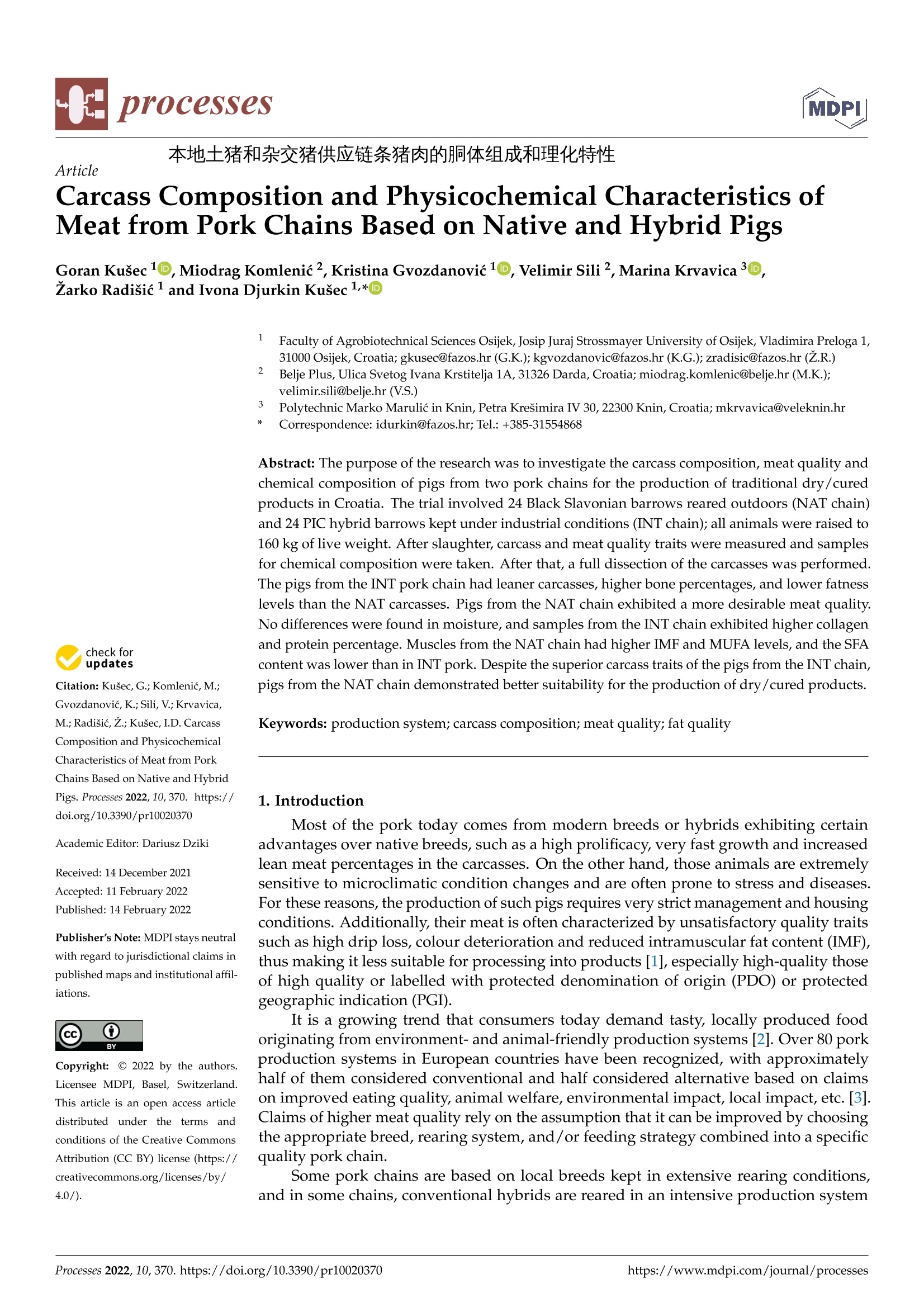
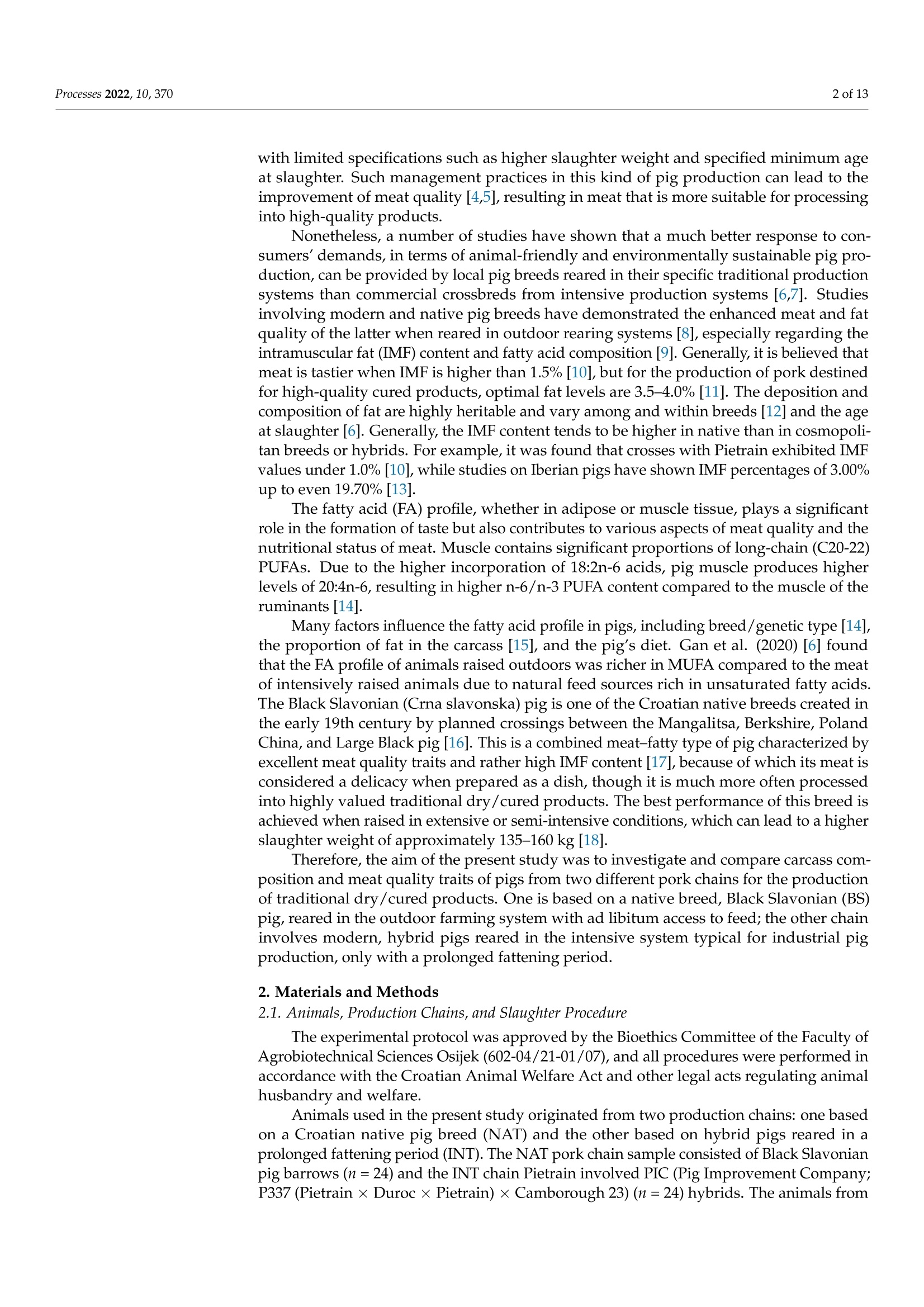
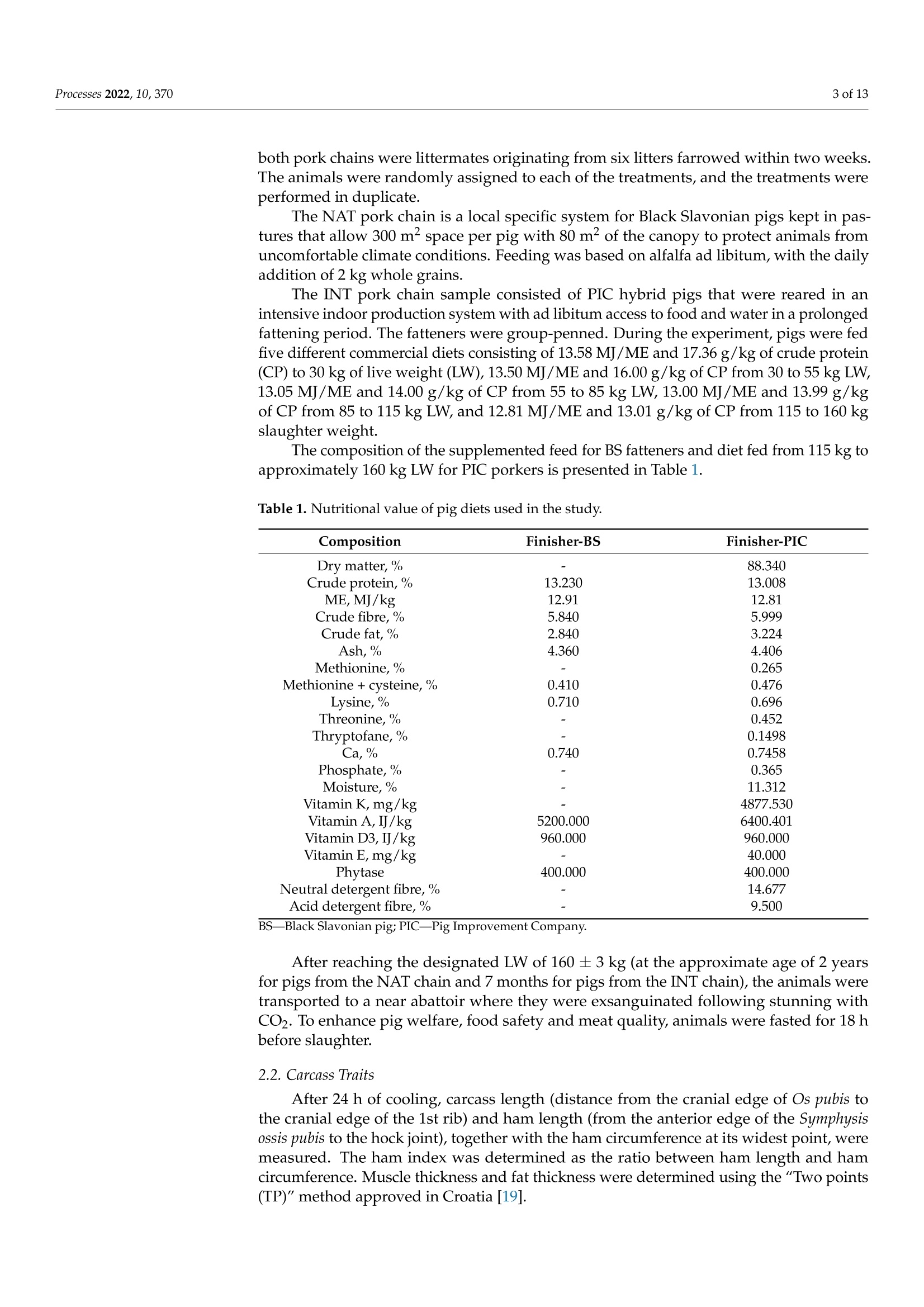
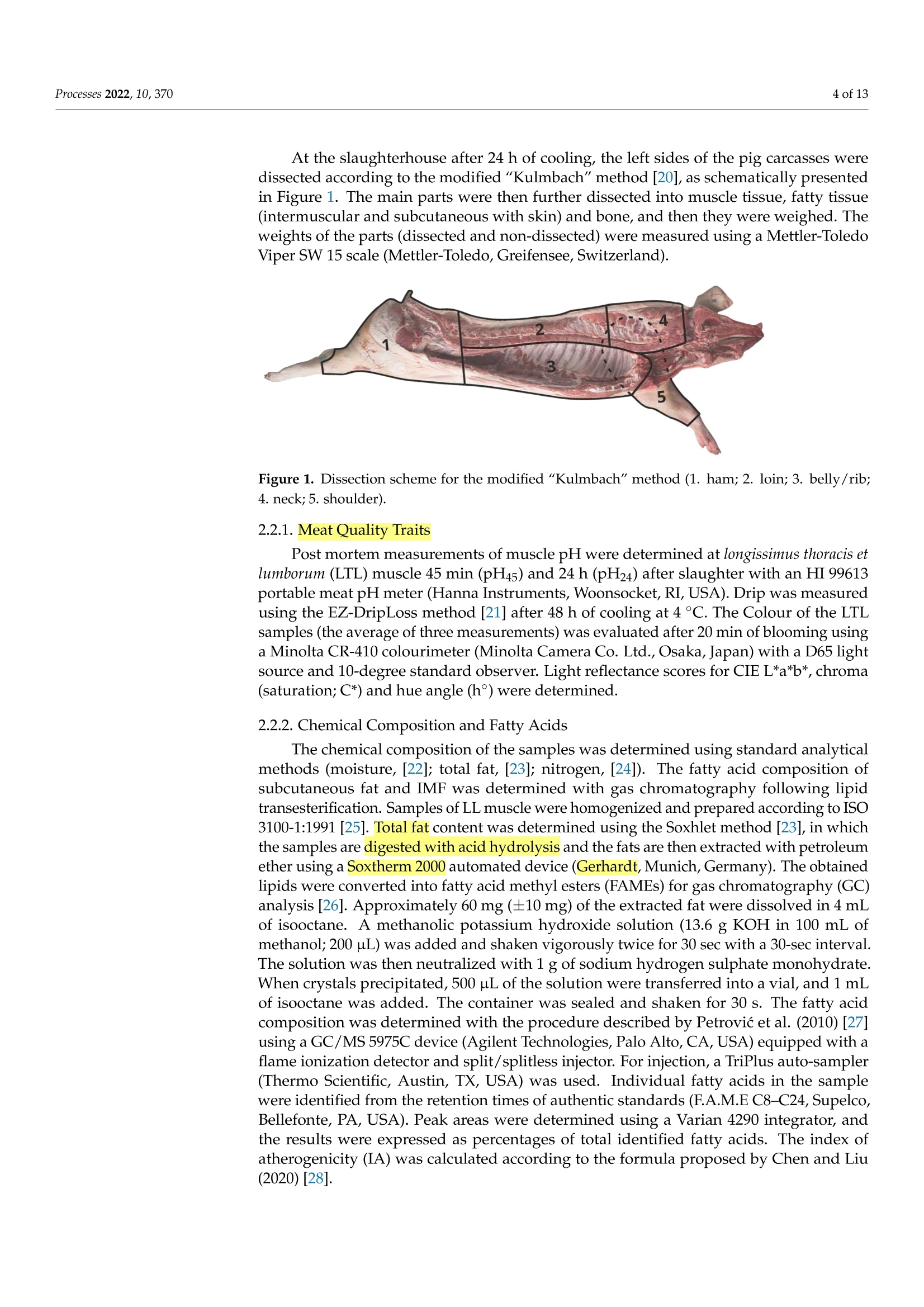
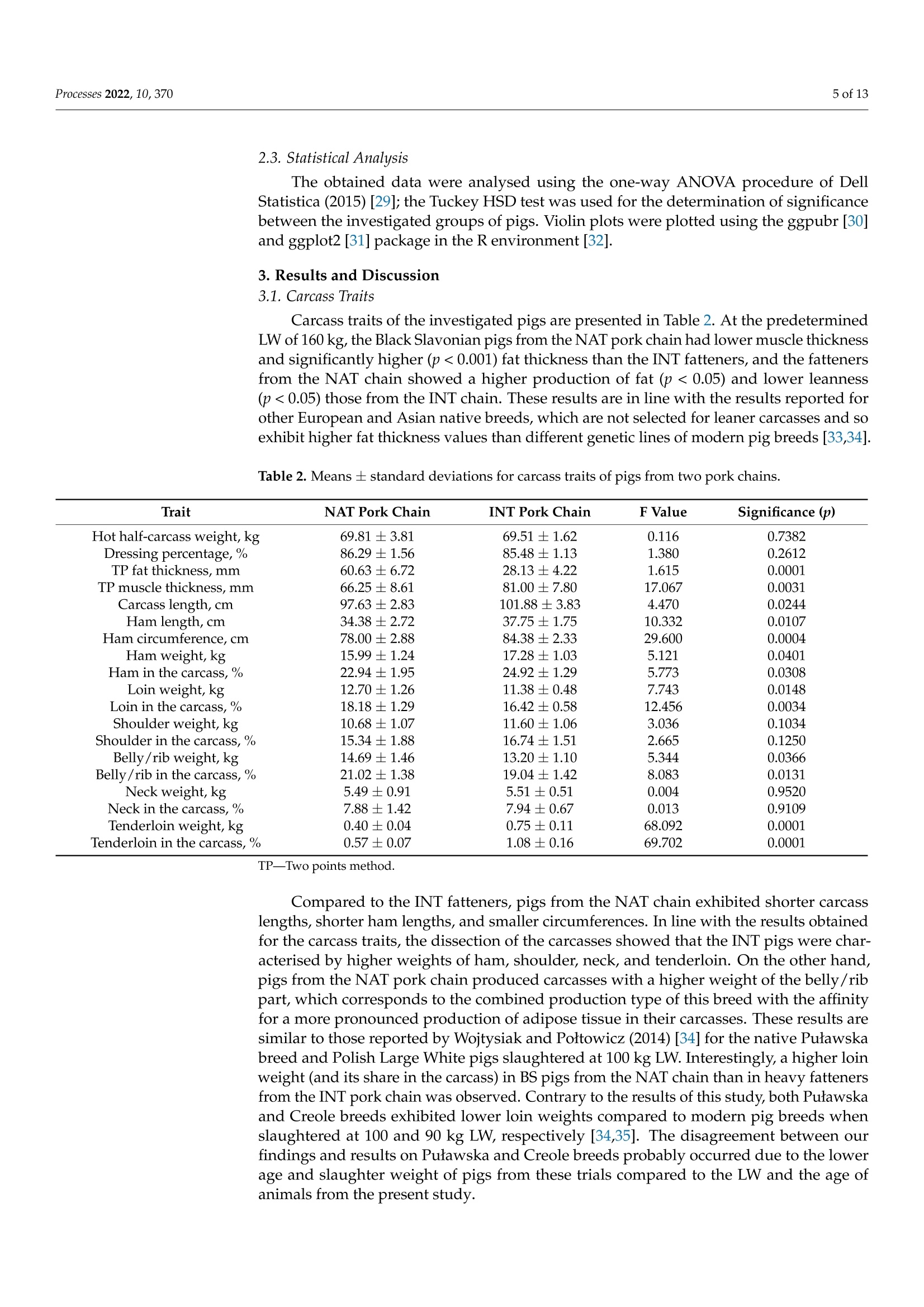
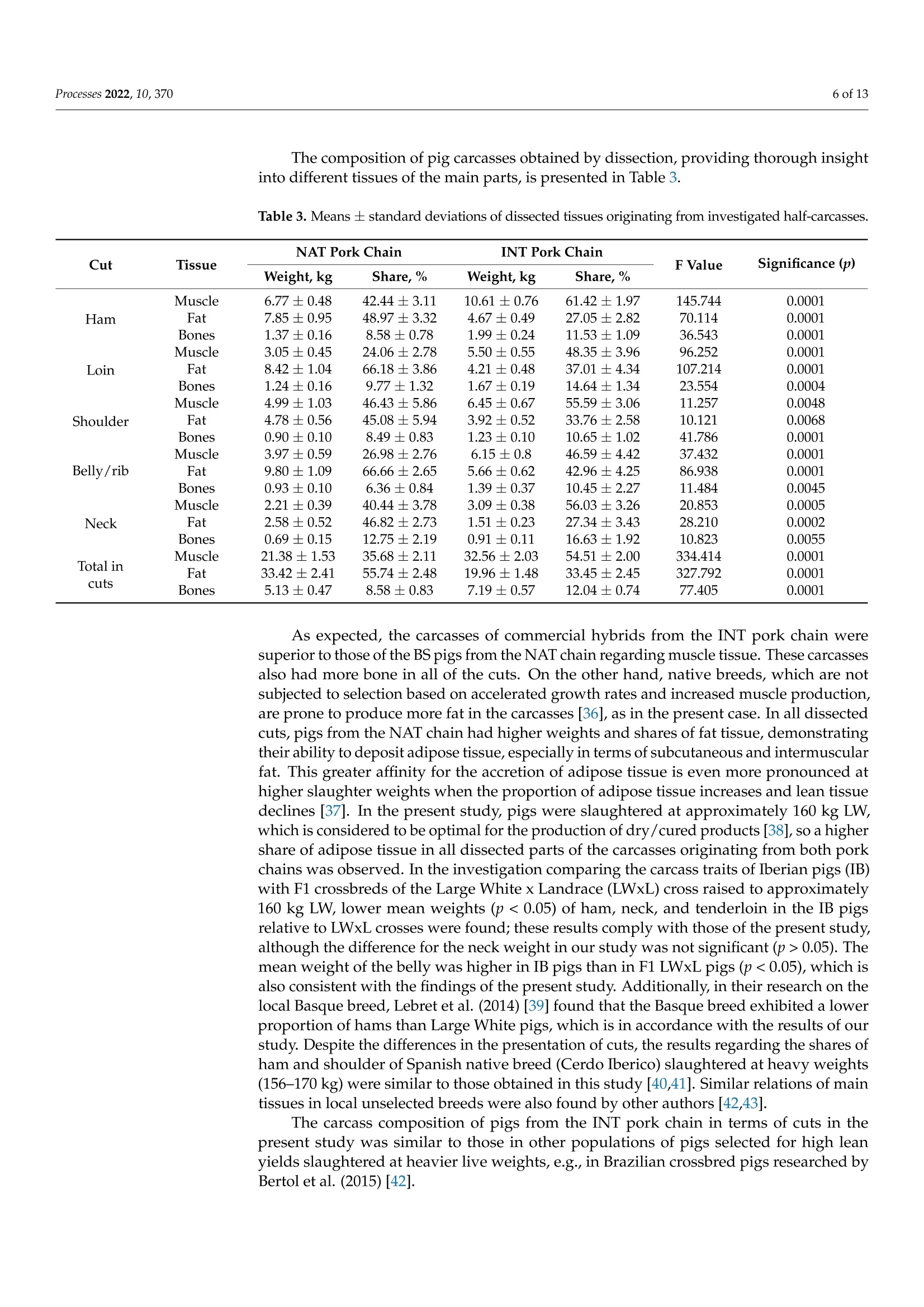
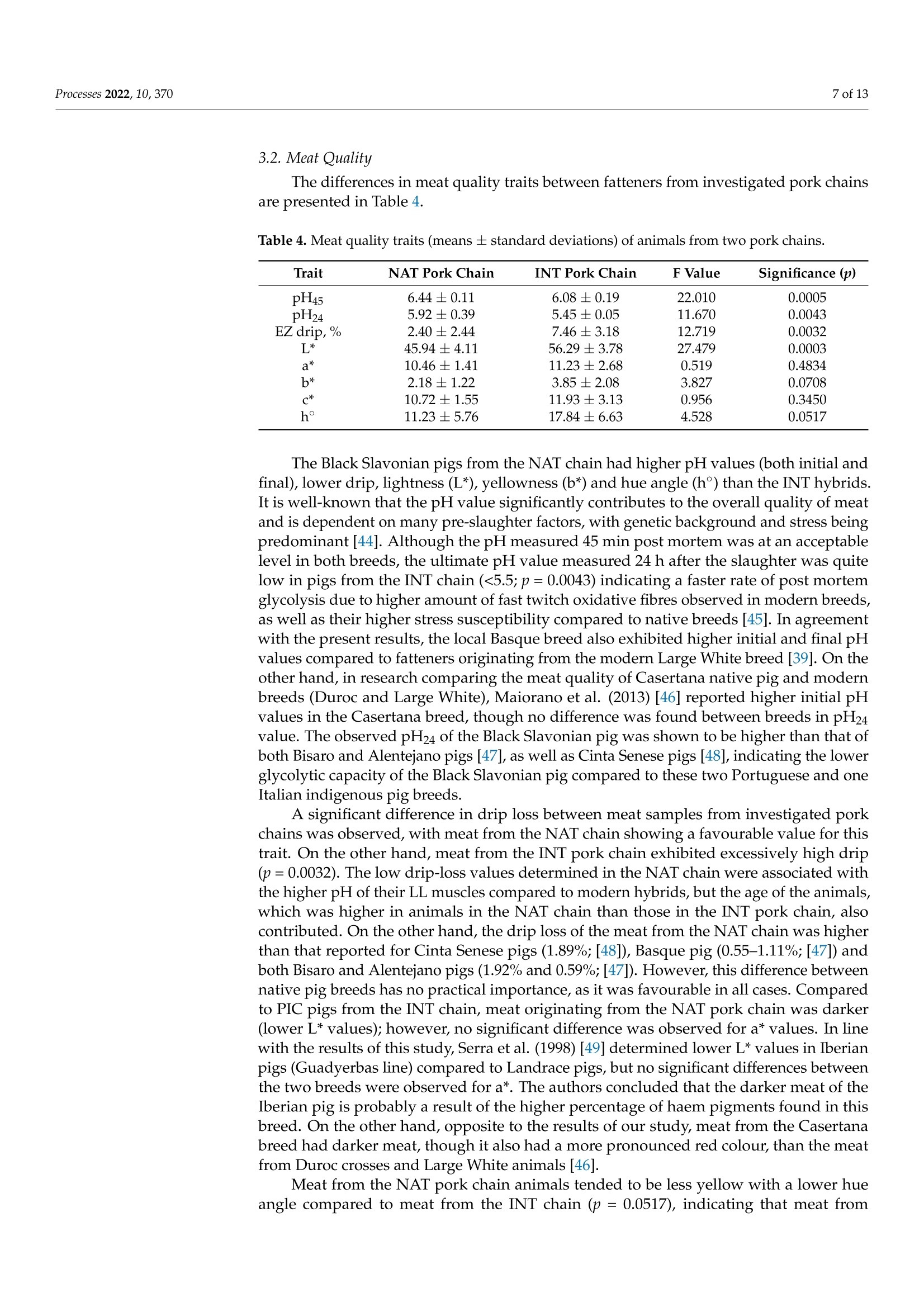
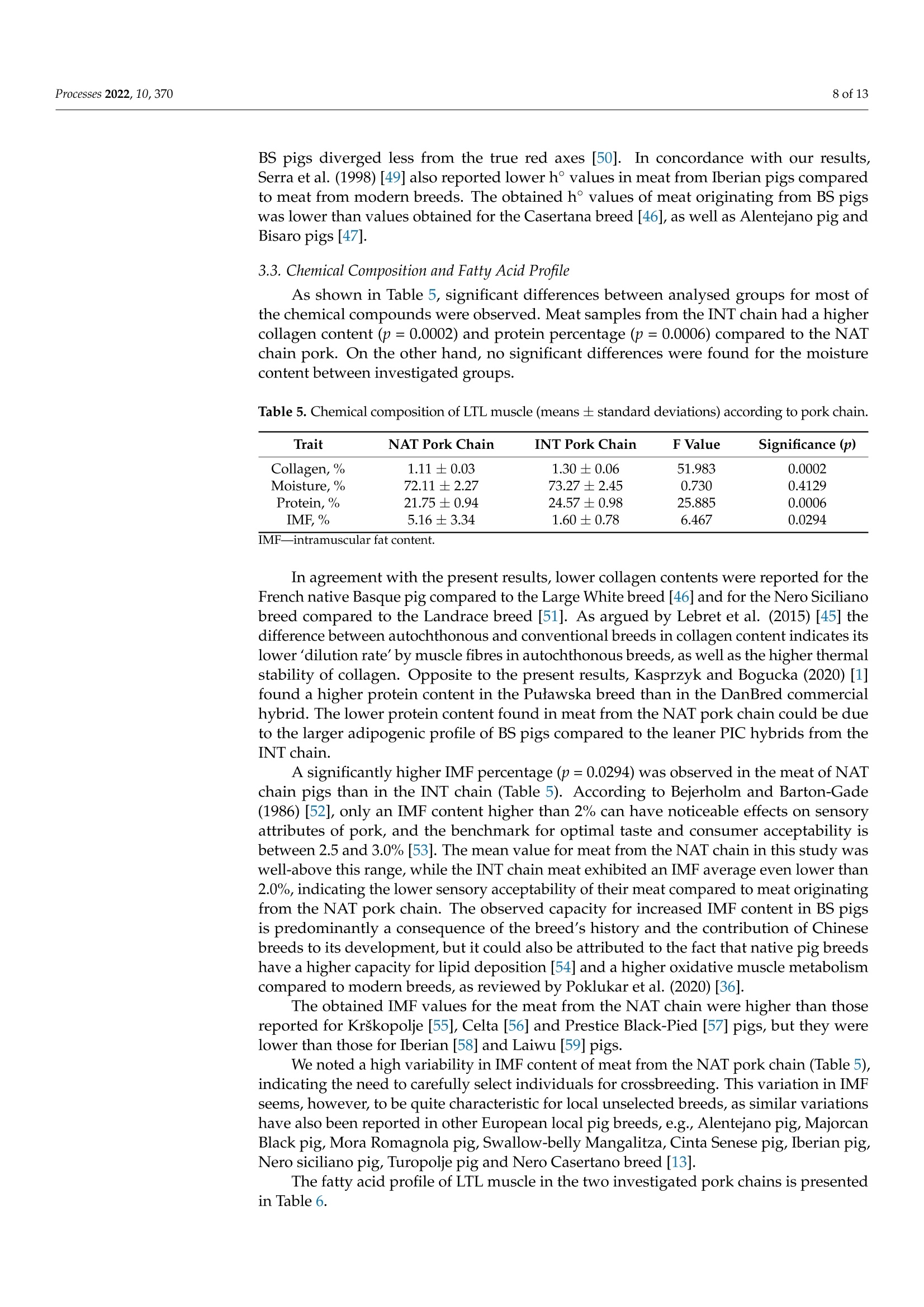

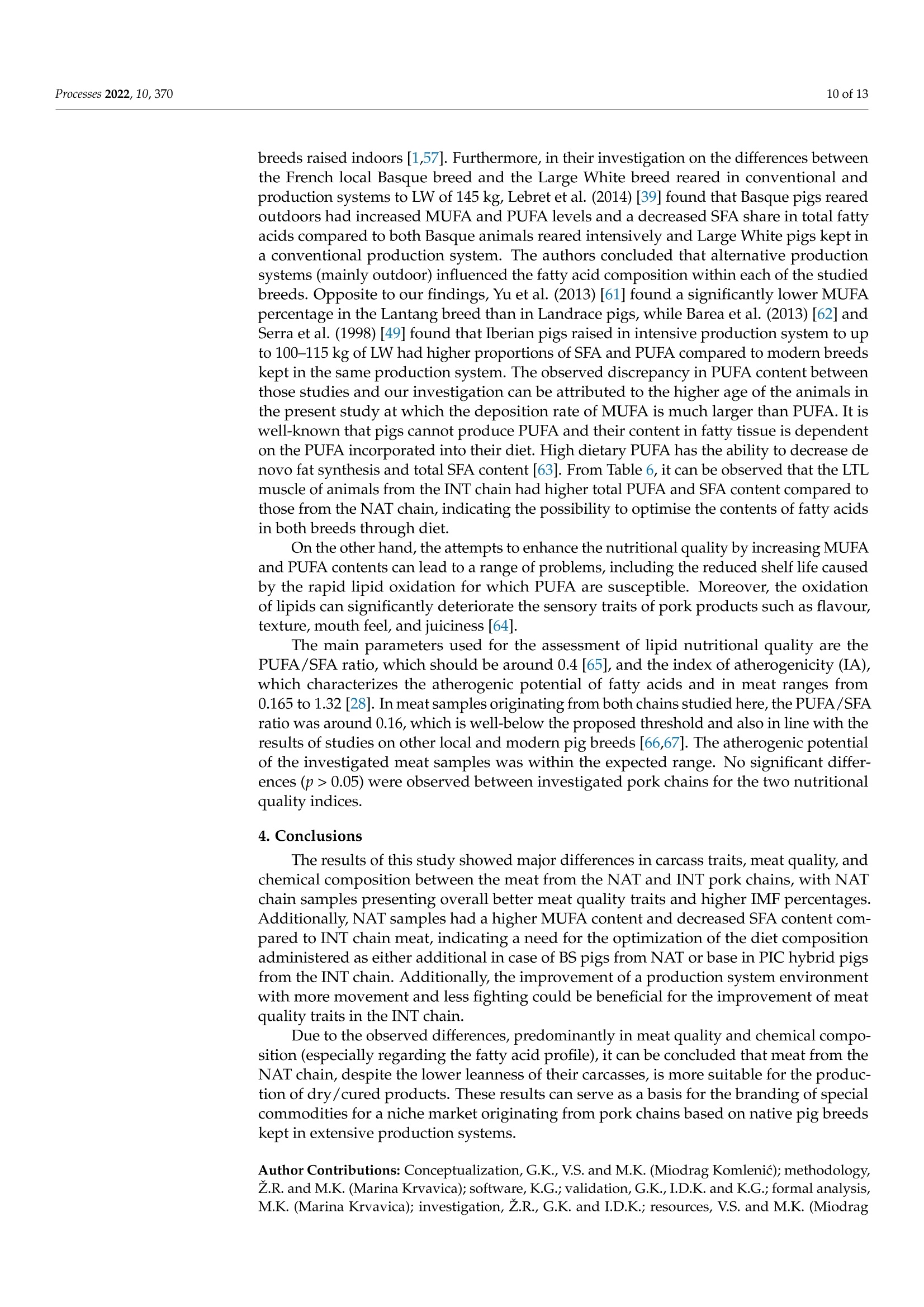
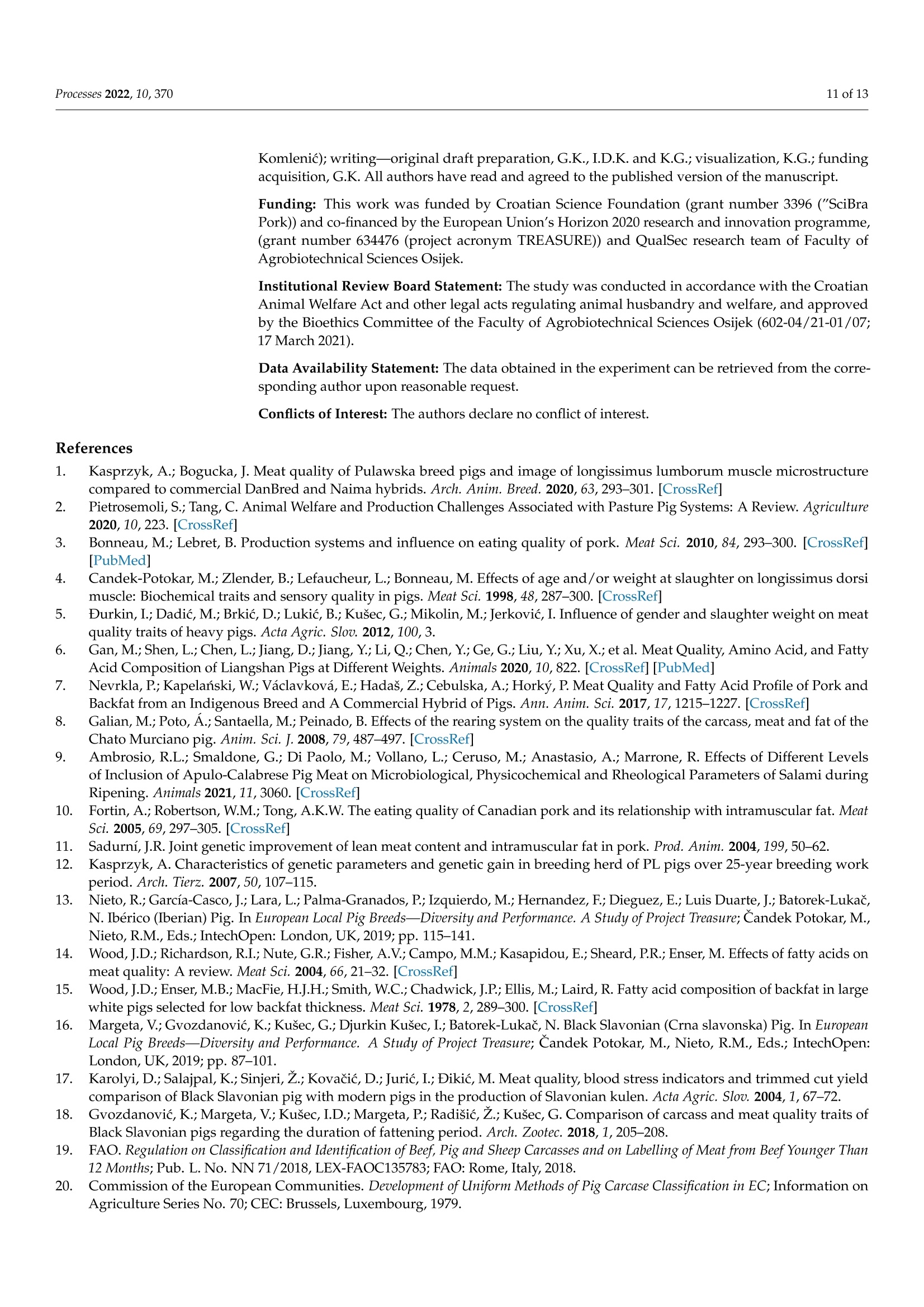
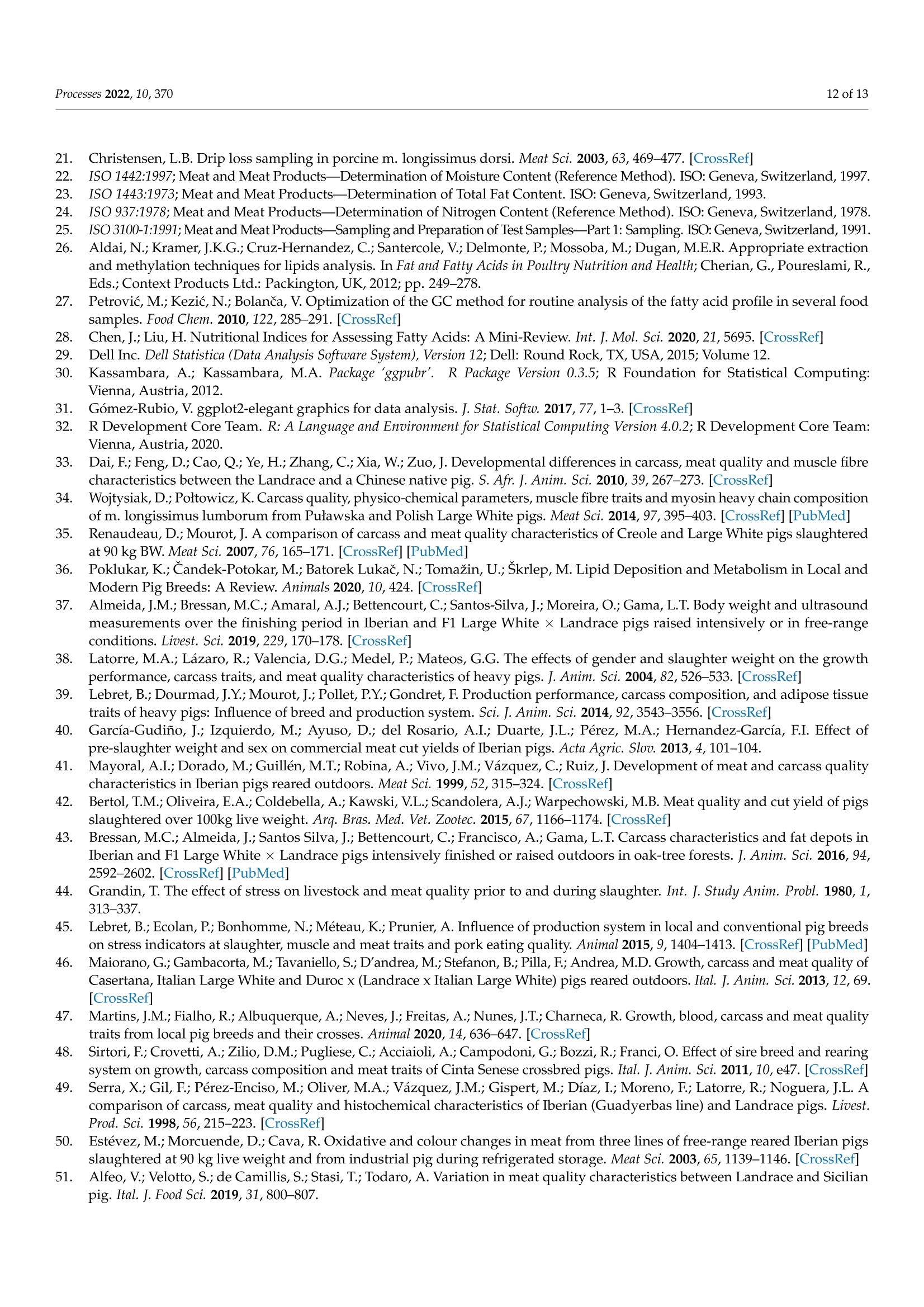

还剩11页未读,是否继续阅读?
中国格哈特为您提供《本地土猪和杂交猪猪肉蛋白质、脂肪以及脂肪酸含量的检测》,该方案主要用于畜禽肉及副产品中营养成分检测,参考标准《GB 5009.6 食品中脂肪的测定》,《本地土猪和杂交猪猪肉蛋白质、脂肪以及脂肪酸含量的检测》用到的仪器有格哈特全自动超级总脂肪测定系统HT6+SOX416、格哈特快速干燥仪STL56、格哈特凯氏消化系统KT8S、格哈特维克松废气实验室废物处理系统涤气VS、格哈特带自动进样器凯氏定氮仪VAP500C、德国加液器MM、滤纸筒
相关方案
更多
该厂商其他方案
更多

